- 0 No item in your cart
- The magazine

Current issue
- All the issues
- My magazines
- Technical specifications
- Multihull of the Year
- Classified Ads
- Destinations
- Online store
- All the magazines
- Subscriptions
- Accessories

Catamaran basics The daggerboards: understanding and adjusting them
Having a catamaran with daggerboards means enjoying better pointing ability than an equivalent model equipped with fixed stub keels, which are inevitably shorter. It means that you can also optimize drag, speed and even safety. Partially integrated, with foils...an inventory of the daggerboards on our boats and how to use these appendages.
Create a notification for Technical
We will keep you posted on new articles on this subject.

Published 01/04/2015
By Emmanuel van Deth
Published: may / june 2015

Choose the option that suits you best!
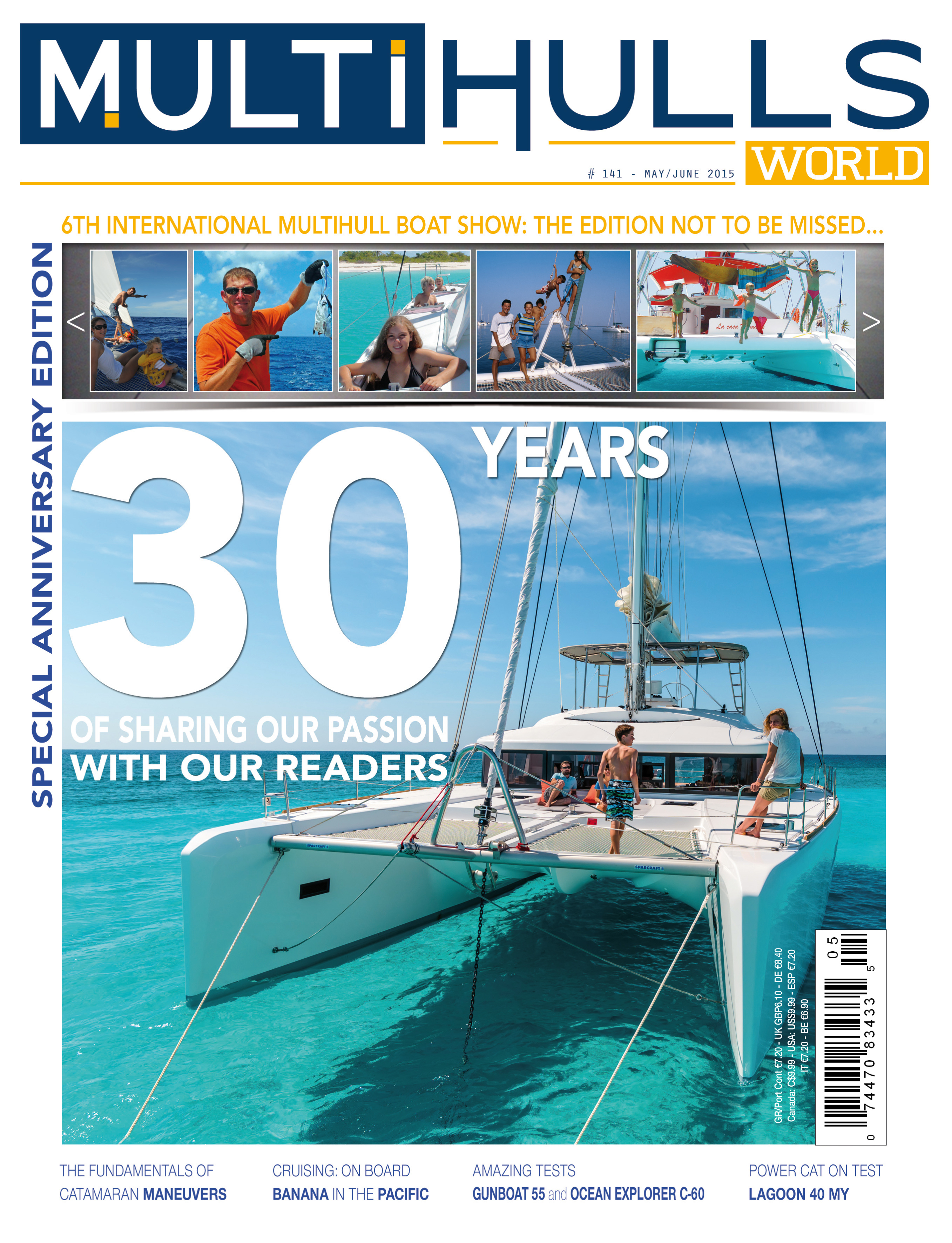
Issue #: 141
Published: May / June 2015
- Price per issue - digital : 5.40€ Digital magazine
- Access to Multihulls World digital archives Digital archives
1) All the Catanas are equipped with daggerboards. They are very long, and held structurally in their cases by the whole height of the hulls. Simple and strong, but beware of the significant windage in the raised position.
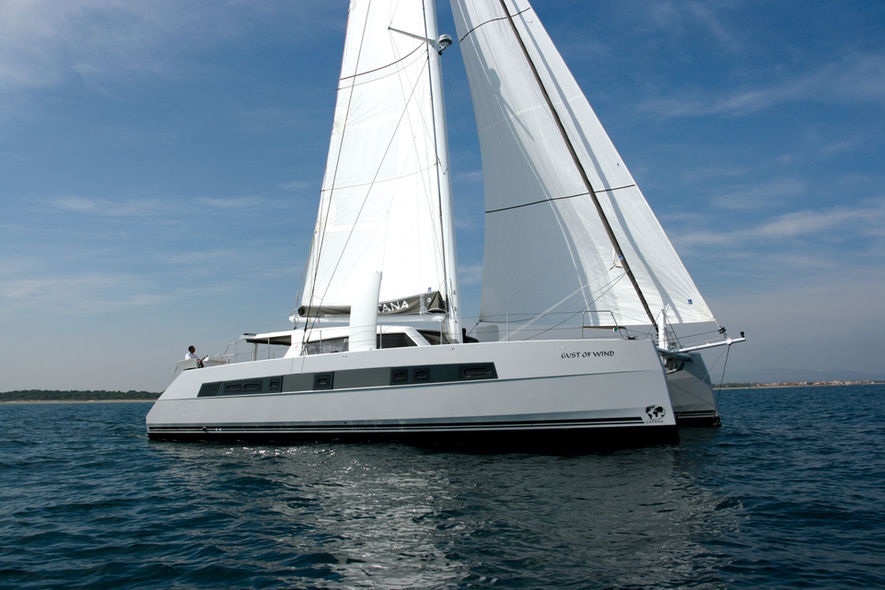
2) The latest Catana models are equipped with curved daggerboards. On the 59, the foil effect is worth 500kg at a speed of 15 knots.
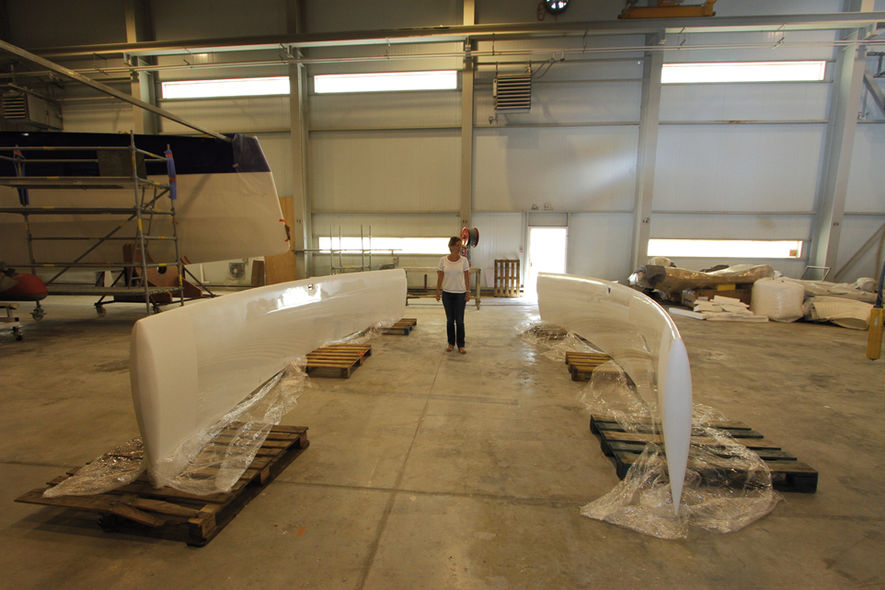
3) The latest Outremers have adopted shorter structural cases, to reduce the size of the daggerboards. Less windage in the raised position and less weight, but the construction is more complex…
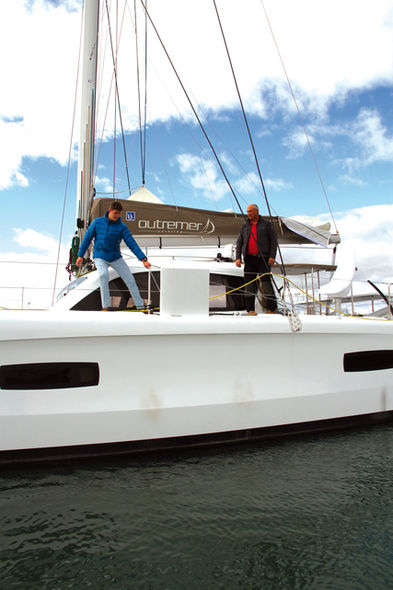
4) Numerous trimarans are also equipped with daggerboards/centerboards. They can be central and integrated into the accommodation, as aboard this Dash 750.
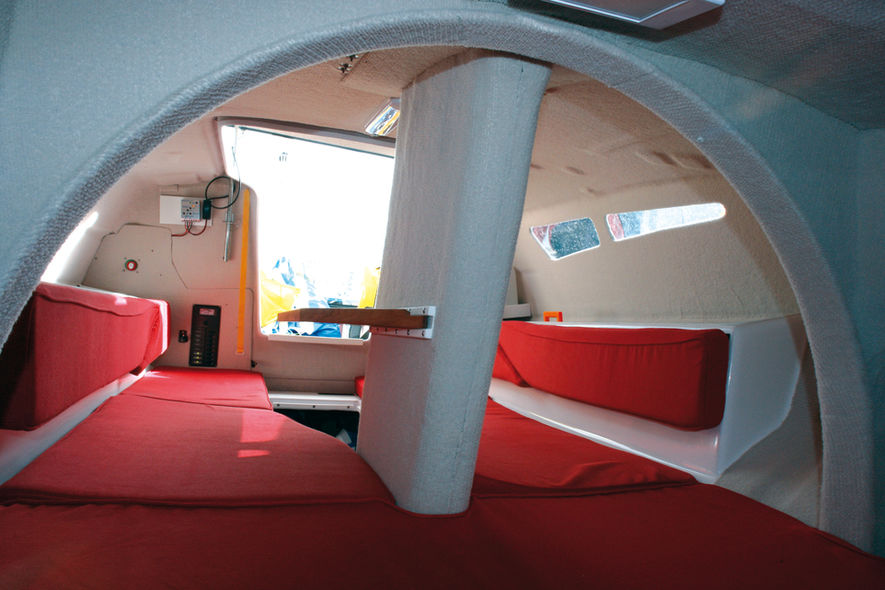
5) Other trimarans, such as the Tricat 25, are equipped with centerboards integrated into the floats.
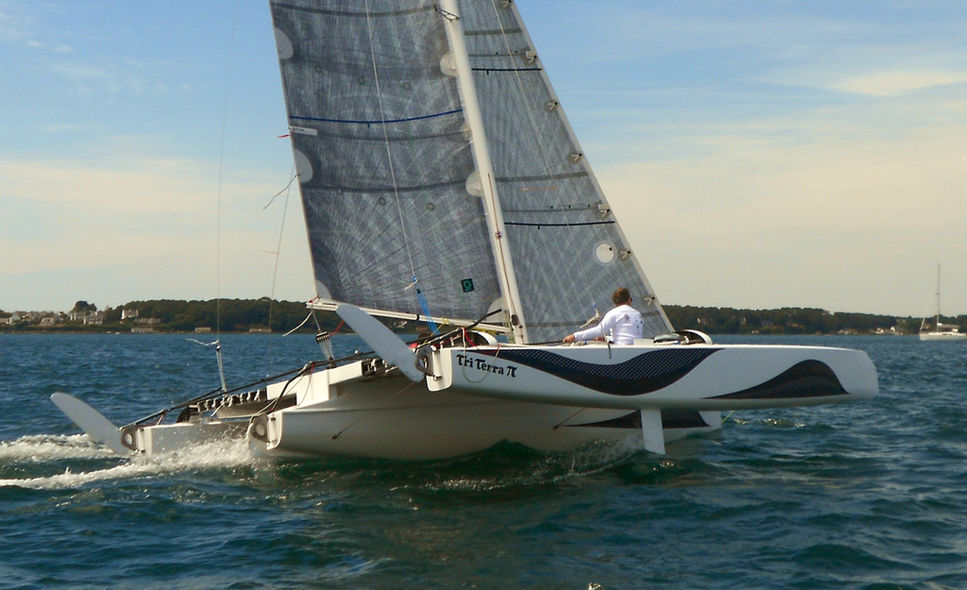
6) Builders such as Outremer provide stopper knots for the daggerboard control lines; a good way to judge the position when the daggerboard is not visible.
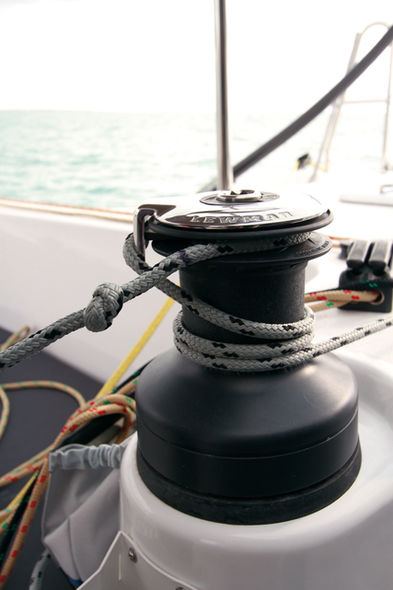
7) Once the daggerboard is out of its case, it is easier to judge: the lifelines are an excellent adjustment indicator!
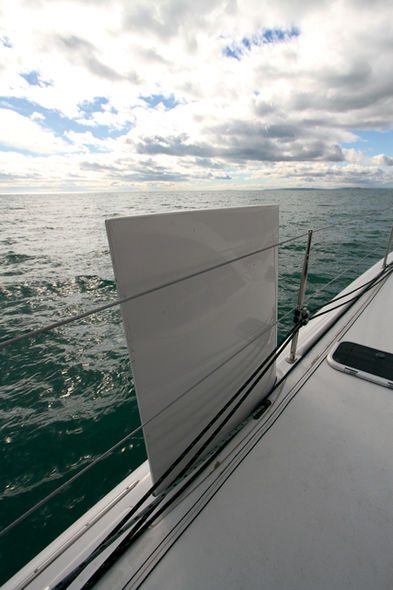
8) To windward in light weather, the daggerboards are fully lowered, to take advantage of maximum 'grip' on the water.
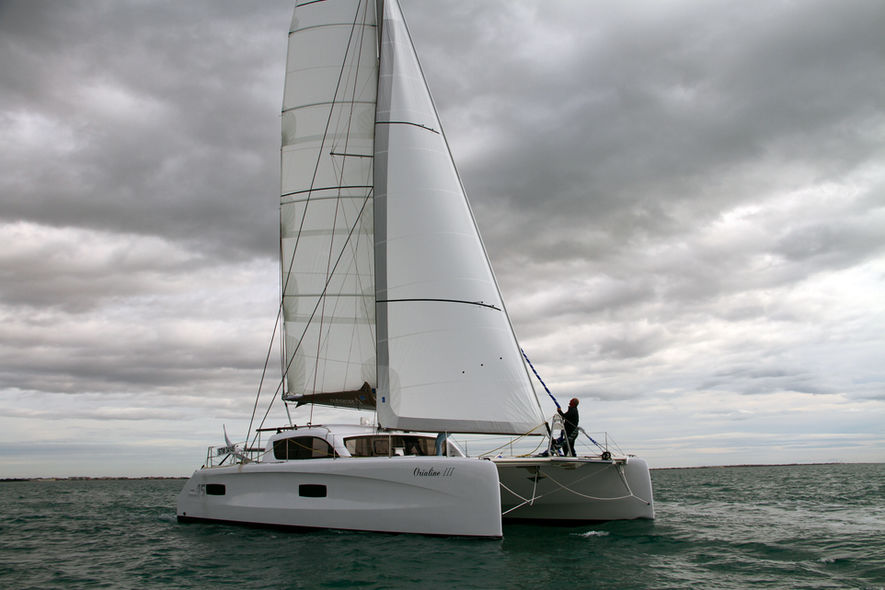
9) When the speed increases, it is worthwhile raising the windward board to optimize drag. Note: a daggerboard which moves is no use. Therefore we raise it!
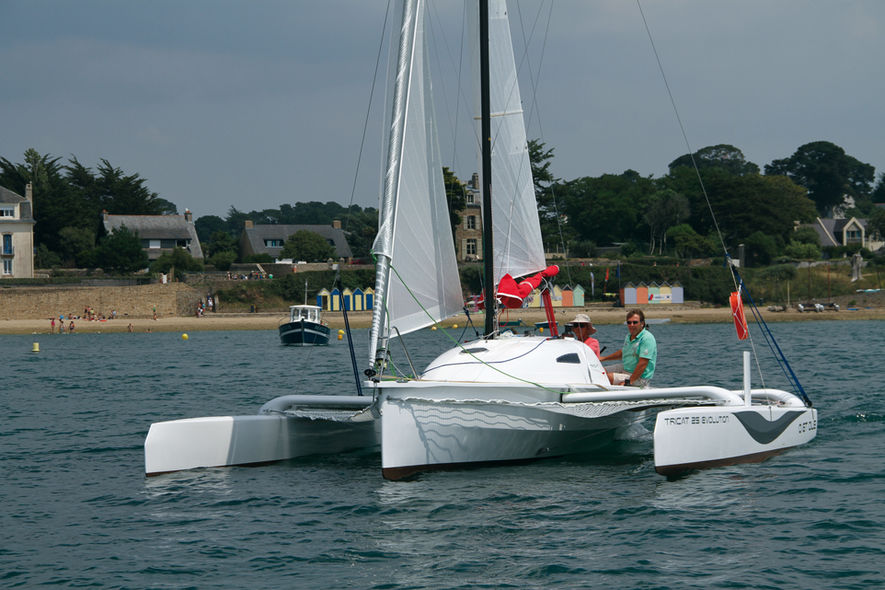
10) But for safety, it is preferable to raise the leeward appendage: in the case of a strong gust, the risk of the boat ‘tripping up’ is thus reduced. The compromise could be to raise both the daggerboards by half... It’s up to you to judge!
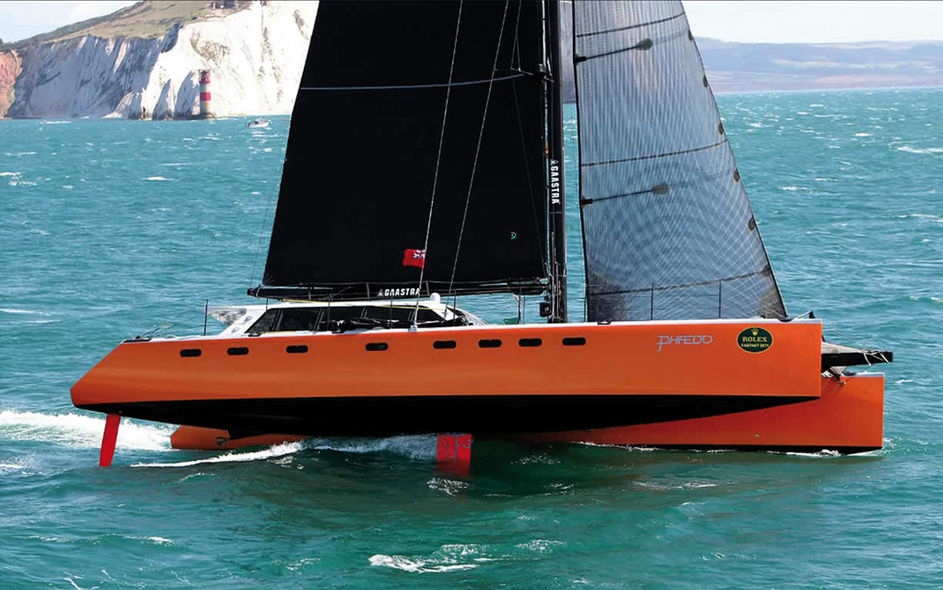
11) Downwind, the daggerboards are no longer useful, especially when the boat exceeds 10 knots... Keeping one third of the surface can however help the helmsman or the autopilot to steer a straighter course.
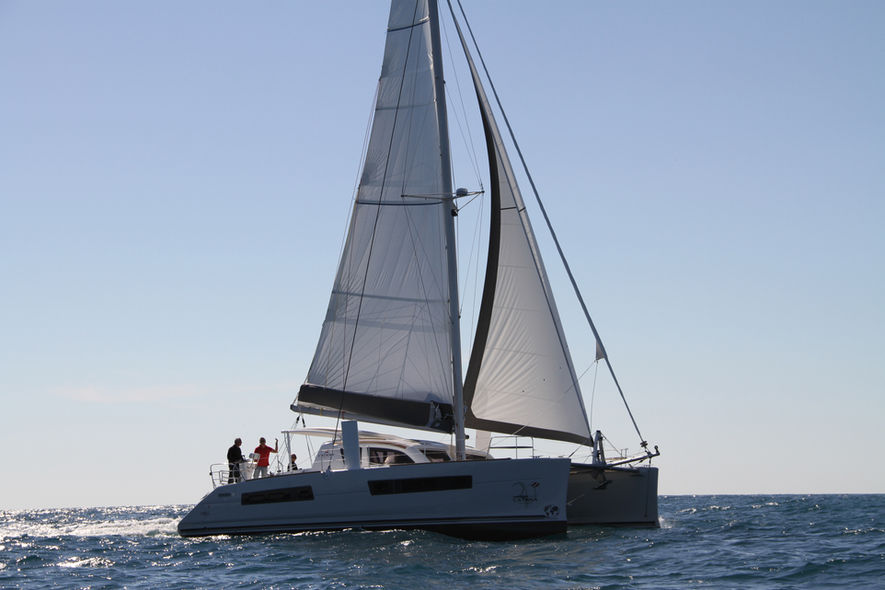
12) Heavy weather? Raise them completely so the hulls slide. On the other hand, with big seas from behind, (just like downwind in more manageable weather) it may be useful to keep a little daggerboard lowered to avoid yawing.
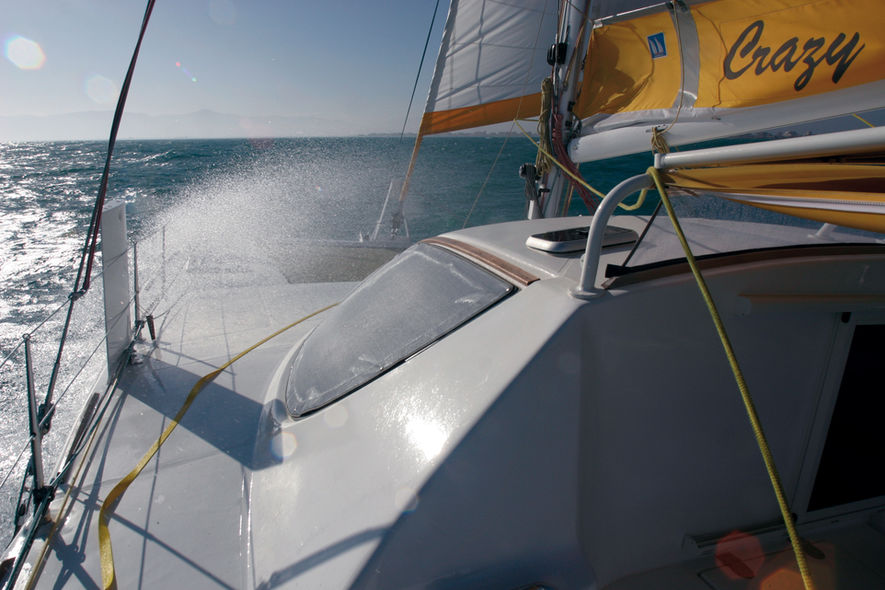
Subscribe to Multihulls World and get exclusive benefits.
Tags :
- préparation ,
- Catamaran basics
Most-read articles in the same category

Drivetrains
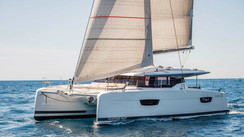
Bending on sails
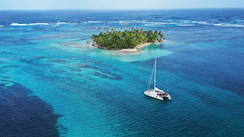
Everything you need to know about trampolines
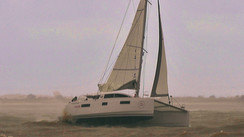
Managing heavy weather in a multihull
What readers think.
Post a comment
No comments to show.
MW #197 - Oct / Nov 2024
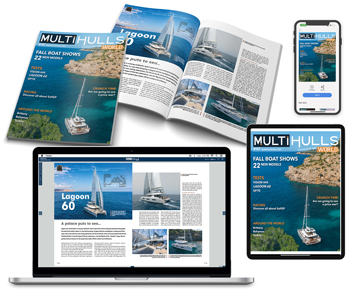
Tenders with two hulls...

Transport under sail

Hydrogen on board
Subscribe now.
The latest news from €3 / month
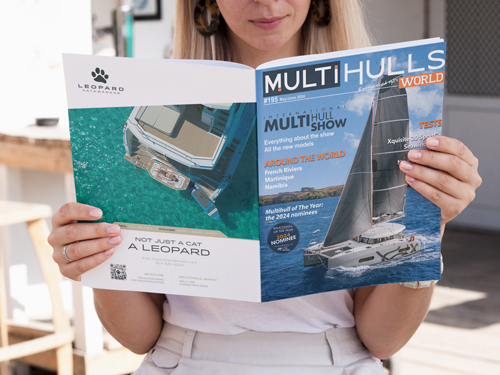
Video of the month
Our latest YouTube hit!

The Multihull of the Year
The 2024 results

Classified ads

Woods Flica 35
Bosgraaf 15m trimaran, minicat 310.

Nautitech 48 0pen Available
Vous avez ajouté " " à vos favoris., vous avez supprimé " " de vos favoris., in order to add this article to your favorites, please sign in..

What Are Daggerboards on a Catamaran? (An In-Depth Look)
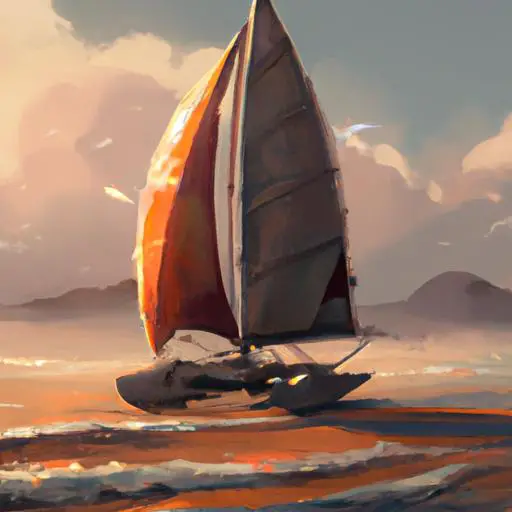
Have you ever wondered how catamarans move so fast and efficiently through the water? The answer lies in daggerboards, a unique and essential feature of these vessels.
Many sailors consider daggerboards to be one of the key advantages of sailing on a catamaran over a monohull sailboat.
If you’re curious to learn more about the science behind this nautical feature, then this article is for you.
Here, we’ll dive into the details of what daggerboards are, how they work, the benefits they offer, the types of daggerboards, and the best practices for maintenance and performance.
By the end, you’ll be an expert on the topic and be able to make an informed decision about the best type of daggerboard for your vessel.
Table of Contents
Short Answer
Daggerboards are vertical boards on a catamaran that can be raised and lowered to provide lateral resistance and stability to the boat.
When the daggerboards are lowered, they provide more stability and can help the catamaran sail closer to the wind.
When they are raised, the catamaran has less resistance and can move faster.
Daggerboards are an important part of a catamaran’s design, as they provide stability and control in difficult weather conditions.
What Are Daggerboards?
Daggerboards are a vertical fin-like structure found on a catamaran, which is a type of sailboat with two hulls of equal size.
Daggerboards are typically located on the centerline of the boat and can be raised and lowered at the skipper’s discretion.
This allows the skipper to adjust the center of effort on the boat, which in turn affects the boat’s maneuverability and control.
At the most basic level, daggerboards provide additional lift and stability to a catamaran, allowing for improved performance in light winds.
They work by creating forward thrust and lift, helping the boat move through the water more efficiently and allowing it to make tighter turns.
Daggerboards also help to reduce leeway, which is the tendency of a boat to drift sideways in the water due to the wind pushing against its sails.
By positioning the daggerboard at an angle, the skipper can reduce the amount of leeway the boat experiences, allowing it to maintain a more consistent course.
Overall, daggerboards are a key component of sailing catamarans and can have a significant impact on the performance of the boat.
With the right setup, they can make a boat faster, more maneuverable, and easier to control in a variety of conditions.
For sailors looking to get the most out of their catamaran, understanding how to use daggerboards is essential.
How Daggerboards Work

Daggerboards, also known as centerboards, are a vertical fin-like structure found on a catamaran.
They are typically located on the centerline of the boat and can be raised and lowered at the skippers discretion.
Daggerboards are designed to provide the catamaran with additional lift and stability in light wind conditions.
This helps to improve the performance of the catamaran by adjusting the center of effort on the boat, allowing for greater maneuverability and control.
When the daggerboards are lowered, they act as an underwater keel, providing additional stability and lift.
This helps the catamaran to cut through the water more efficiently, allowing it to move faster and with greater control.
The daggerboards also help to prevent the boat from drifting sideways in the wind, which can be a common issue with monohulls.
The daggerboards also help to reduce the amount of heeling (leaning) experienced when sailing upwind, making the sailing experience more comfortable and enjoyable.
When the daggerboards are raised, the catamaran will be more maneuverable and have improved performance in light wind conditions.
This is due to the reduced drag caused by the daggerboards not being in the water.
The raised daggerboards will also help to reduce the amount of heeling experienced when sailing downwind, making the sailing experience more comfortable and enjoyable.
The use of daggerboards can significantly improve the performance of a catamaran in light wind conditions and is a key component of sailing catamarans.
By raising and lowering the daggerboards, the skipper can adjust the center of effort on the boat, allowing for greater maneuverability and control.
The Benefits of Daggerboards
Daggerboards are an essential part of sailing catamarans for a number of reasons.
The most obvious benefit of having daggerboards on a catamaran is that they provide additional lift and stability, allowing for improved performance in light winds.
By raising and lowering the daggerboards, the skipper can adjust the center of effort on the boat, giving them greater control over the boat’s maneuverability.
This can be advantageous in tricky situations, such as sailing close-hauled or in tight spaces.
Additionally, daggerboards can help reduce drag in certain conditions.
By raising the daggerboards, the boat can be steered more efficiently by using the hulls to provide lift instead of the daggerboards, which can result in less drag and improved performance.
Finally, daggerboards can help improve the safety of a catamaran.
In rough seas, daggerboards can provide additional stability, helping to keep the boat upright and preventing it from capsizing or being damaged.
This can be especially beneficial when sailing in unfamiliar waters or in bad weather conditions.
In summary, daggerboards are an invaluable component of sailing catamarans.
They provide added lift and stability, can be used to adjust the center of effort on the boat, reduce drag, and improve the safety of the boat.
With all these features, it’s no wonder that daggerboards are a must-have for any serious catamaran sailor.
Types of Daggerboards

When it comes to daggerboards, there are two main types that can be found on a catamaran: retractable and fixed. Retractable daggerboards are typically made of fiberglass and can be raised and lowered at the skipper’s discretion. This allows the skipper to adjust the center of effort of the boat, providing improved maneuverability and control. Fixed daggerboards are usually made of wood or metal and are permanently mounted in the centerline of the boat. These boards provide an extra layer of stability and lift to the catamaran, allowing it to perform better in light winds.
In addition to the two main types of daggerboards, there are also some other variations that can be found on some catamarans.
A daggerboard trunk is a type of daggerboard that is mounted inside the hull of the boat.
This allows the daggerboard to be raised and lowered without having to be removed from the boat.
A foil daggerboard is a type of retractable daggerboard that is designed to provide additional lift and stability to the catamaran, allowing it to perform better in heavier winds.
There are also battened daggerboards, which are a type of fixed daggerboard that is designed to provide additional lift and stability to the catamaran.
No matter which type of daggerboard is chosen, they all provide additional lift and stability to a catamaran, allowing it to perform better in different wind conditions.
By understanding the different types of daggerboards and how they can improve a catamaran’s performance, skippers can make the most of their sailing experience.
Daggerboard Maintenance
Daggerboard maintenance is an important aspect of owning and sailing a catamaran.
It is important to keep the boards in good condition to ensure they are performing as efficiently as possible.
This means periodically checking the boards for wear and tear, making sure they are properly lubricated and free of debris, and ensuring that the fastenings and connections are secure.
Regularly inspecting the boards for signs of corrosion or damage is also important.
If damage is found, it should be addressed immediately to prevent further damage and to ensure that the boards are performing as efficiently as possible.
In addition to inspecting the boards, it is important to keep them lubricated to ensure smooth and efficient performance.
The best way to do this is by regularly applying a lubricant specifically designed for marine use.
This will help reduce friction and keep the boards in good condition for longer.
It is also important to keep the fastenings and connections of the boards secure.
This includes the bolts that attach the boards to the frame, as well as the pins and clips that hold the boards in place.
It is important to inspect these regularly for signs of wear and tear, and to replace them if necessary.
Finally, it is important to keep the boards free of debris or dirt.
This can be done by regularly rinsing the boards off with fresh water after sailing, and by using a soft brush to remove any dirt or debris that has accumulated.
By following these simple maintenance tips, you can ensure that your daggerboards are performing as efficiently as possible and that your catamaran is sailing to its full potential.
Daggerboard Upgrades

The daggerboard is a key feature on catamarans, as it provides lift and stability to the boat.
It is located on the centerline of the boat and can be raised and lowered at the skipper’s discretion.
This allows the skipper to adjust the center of effort on the boat, enabling greater maneuverability and control.
For those looking to maximize the performance of their catamaran, there are several upgrades available for the daggerboard.
A taller daggerboard can be installed to increase the lift and reduce drag, while a lower profile board can provide improved stability.
Additionally, a carbon fiber board can be used to reduce weight, further increasing the overall performance of the boat.
Another upgrade is the addition of a daggerboard trim tab, which allows for more precise control of the daggerboard.
This is especially useful in light winds, as it allows the skipper to adjust the daggerboard to maintain the optimum angle of attack.
This can significantly improve the performance of the boat in light winds.
Finally, there are a variety of shapes available for the daggerboard.
Different shapes are designed to optimize the performance of the boat in different conditions, so it is important to select the shape that best suits your needs.
In conclusion, daggerboards are a key component of sailing catamarans and can have a significant impact on the performance of the boat.
By upgrading the daggerboard, skippers can maximize the performance of their catamaran and improve its overall maneuverability and control.
Daggerboard Performance
When it comes to sailing performance, daggerboards can have a significant impact on a catamaran.
When the daggerboards are up, the center of effort is lowered, allowing the catamaran to sail in light winds with better speed and efficiency.
When the daggerboards are down, they provide additional lift and stability, allowing for improved performance in heavier winds.
The shape and size of the daggerboard also affects the performance of the catamaran.
A wide, shallow daggerboard will provide more lift in light winds, while a narrow, deep daggerboard will provide more stability in heavier winds.
As such, it is important to choose the right daggerboard for your catamaran to get the most out of it.
In addition to improving the performance of the boat, daggerboards can also help reduce drag when sailing upwind.
When sailing upwind, the daggerboards create a venturi effect, which helps reduce the drag on the boat.
This can make a huge difference in performance and can allow the catamaran to reach higher speeds in upwind conditions.
Finally, daggerboards can make a catamaran more responsive to steering.
When sailing downwind, the daggerboards can be used to help the boat turn more quickly and with greater precision.
In this way, the daggerboards can be used to make a catamaran more responsive and agile.
By adjusting the daggerboards, the skipper can adjust the center of effort on the boat, allowing for greater maneuverability and control.
Daggerboards can also help reduce drag when sailing upwind and make the catamaran more responsive to steering.
Final Thoughts
Daggerboards are a key component of sailing catamarans, and their presence has a significant impact on the performance of the boat.
They can provide additional lift and stability, allowing for improved performance in light winds, as well as greater maneuverability and control.
With the variety of daggerboard types, upgrades, and maintenance available, there is something for every boat and sailor.
Understanding how daggerboards work and the impact they can have on sailing performance can help you make the most of your catamaran.
So, take the time to consider the different options and see what daggerboards can do for you.
James Frami
At the age of 15, he and four other friends from his neighborhood constructed their first boat. He has been sailing for almost 30 years and has a wealth of knowledge that he wants to share with others.
Recent Posts
When Was Banana Boat Song Released? (HISTORICAL INSIGHTS)
The "Banana Boat Song" was released in 1956 by Harry Belafonte. This calypso-style song, also known as "Day-O," became a huge hit and remains popular to this day for its catchy tune and upbeat...
How to Make Banana Boat Smoothie King? (DELICIOUS RECIPE REVEALED)
To make a Banana Boat Smoothie King smoothie at home, start by gathering the ingredients: a ripe banana, peanut butter, chocolate protein powder, almond milk, and ice. Blend the banana, a scoop of...
- Outremer 45
- Outremer 4X
- Outremer 4.zero
- Outremer 52
- Outremer 55
- Outremer 51
- Outremer 5X
- All the Outremer Fleet
- Personalized support
- Blue Water Sailing Seminars
- Our concept
- The Outremer team
- Our commitments
- Construction principles
- Our catamaran services
- After-sales customer service & Quality control
- Offshore Connected Catamaran Maintenance
- Concierge Services
- Our owners’ stories
- FAQ – Outremer catamarans

- Brokerage: used catamarans for sale
- Privacy Policy
- Legal Notice
- Grand Large Yatching
Daggerboards: how to adjust them on your catamaran
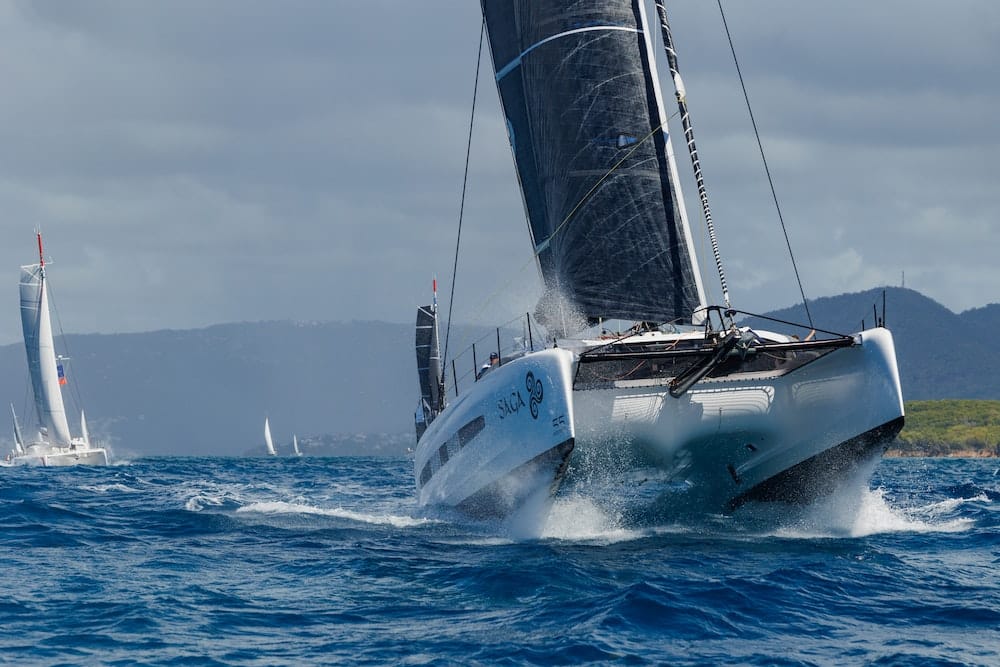
Author : Nikki Henderson
When I asked the Outremer Ladies’ community for suggestions on webinar topics, ‘Daggerboards’ was top of the list. I wasn’t surprised. I don’t think I’ve had a day out on an Outremer with prospective or current owners where daggerboards were not discussed.
It makes sense that there is a curiosity about daggerboards; using them properly is essential if you want your Outremer to perform. What is interesting though, is how confusing people find them.
One thing I’ve realised is that for some people, the issue is similar to my relationship with electronics (hate) and engineering (love). Things I cannot physically see are inherently cloaked in mystery and much more challenging for me to understand. This can be the case with daggerboards: they are hidden underwater and so are often forgotten or misunderstood.
The other reason that daggerboards can be confusing is that they affect not just the performance of a catamaran, but also the safety. Sometimes the theories contradict each other and lead to conflicting advice as to the right and wrong way to use them. In fact, there is no one ‘rule’ about daggerboards. The key, as with anything on a boat, is to understand the reasoning behind the basic daggerboard practices, so that you can make your own decision based on your own unique circumstances that you encounter at any particular time.
I hope this blog will help you build this critical foundation of understanding so that you can set sail safely and with confidence. Daggerboards – like sail trim – is a subject of continual learning. See this as step 1 in the life-long journey.
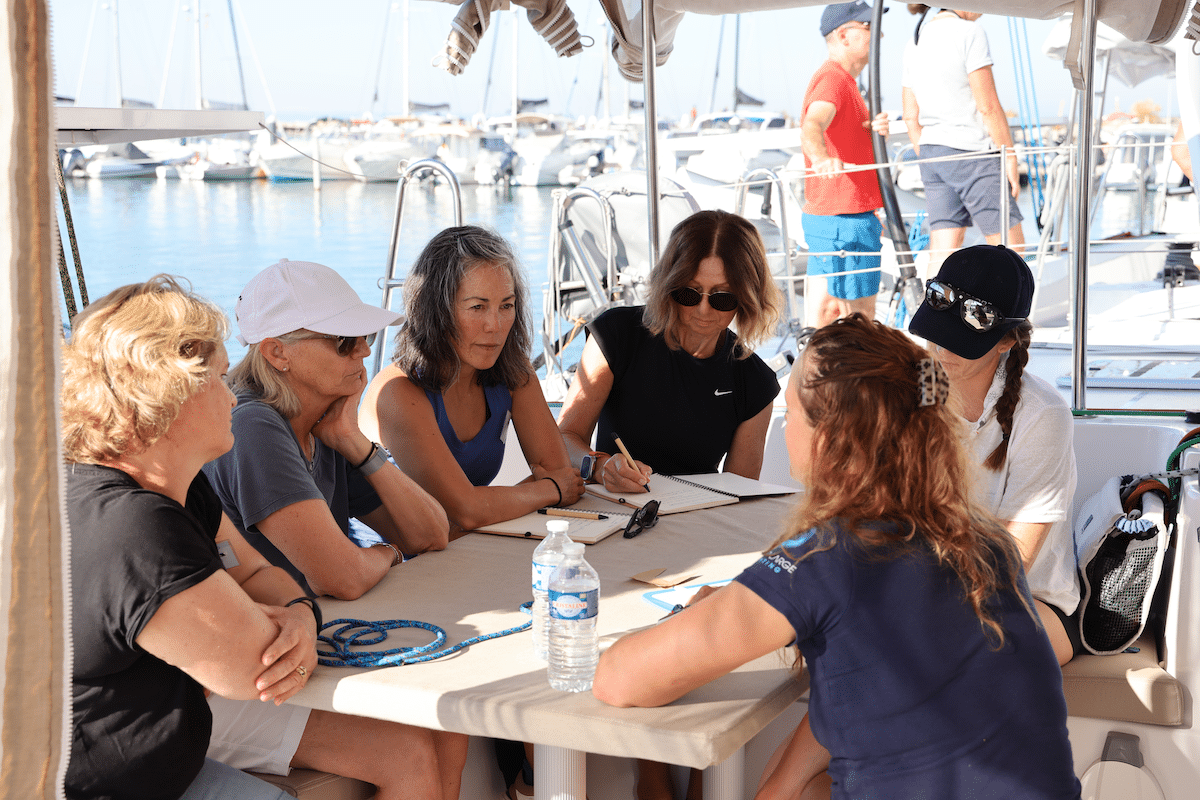
Catamaran daggerboards: how should they be adjusted for optimum sailing?
Daggerboards are best thought of as an ‘underwater sail’ – sometimes called a ‘foil’. Just as a sail above the water needs trimming – so does the sail under the water. But unlike the sail above the water, the daggerboard only has one trim option: how much of it is exposed below the hull.
When sailing upwind the daggerboards provide resistance and lift under the water to balance out the sideways effort force from the sail above the water. In more simple terms, daggerboards help the boat move forward rather than sideways when sailing upwind. Therefore, when sailing upwind, the assumed best practice is to have the daggerboards down. [UP-wind = DOWN-board]
When sailing downwind, the effort force from the sail works almost entirely in the direction you need the boat to go. Therefore, you do not need the resistance under the water from the daggerboard to help with the direction. In fact, it will probably hinder you from sailing deep downwind and slow you down. Therefore, when sailing downwind, the assumed best practice is to have the daggerboards up. [DOWN-wind = UP-board]
Generally, when sailing with wind on the beam – a good ‘go-to’ trim set up is one that is somewhere in the middle of downwind and upwind trim. Therefore, a good starting point for a beam reach would be to lift the daggerboards half-way up.
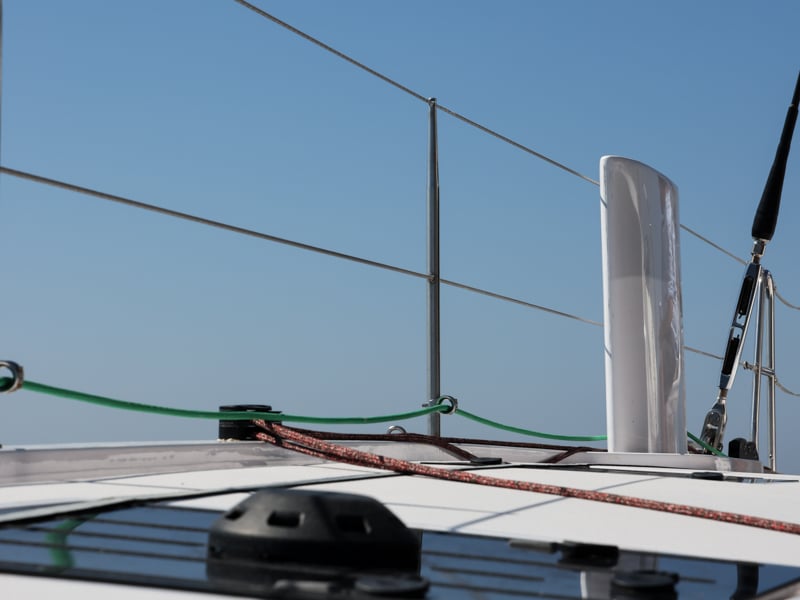
Which catamaran daggerboard for which sailing conditions?
For any competent dinghy sailors who understand daggerboards, this is the most common question as they are typically used to using only one!
An important key principle, is that a daggerboard is only effective when it is submerged in the water. Therefore, if you were sailing the boat purely for performance in a flat sea, you would always need to be trimming at least the leeward one. If the windward hull lifts slightly here and there (which it does fractionally in any substantial wind) then the windward daggerboard is not working efficiently.
Do you drop the windward board? In relation to performance, this depends on how much underwater resistance you need.
In very light winds, the standard practice is to lift the windward daggerboard all the way and only trim the leeward board. When both daggerboards are down, (for simplicity) there is now double the ‘underwater sail’ area. This would likely imbalance how much power there is from the light winds on the sail above the water, and literally ‘drag’ the boat and slow her down.
As the winds increase, there may be a time where you feel you want more underwater resistance, and you could consider lowering the windward board as well. You might find your course over ground improves. Then it was a good decision. If your speed decreases, it might be creating too much drag and you should lift it back up.
If the wind continues to increase further, it is likely you will choose to reef the main. If we return to the concept of the daggerboard being the ‘underwater sail’, if you reef the main, then consider reefing the daggerboard and lifting some up slightly with each reef you put in upwind to keep the boat balanced.
You may be wondering how such a tiny thing as a daggerboard could balance out the enormous sail area of a main sail. The answer here is that water is a much denser fluid than air, and so the daggerboard needs much less area to create the same force than it would do if it were in air.
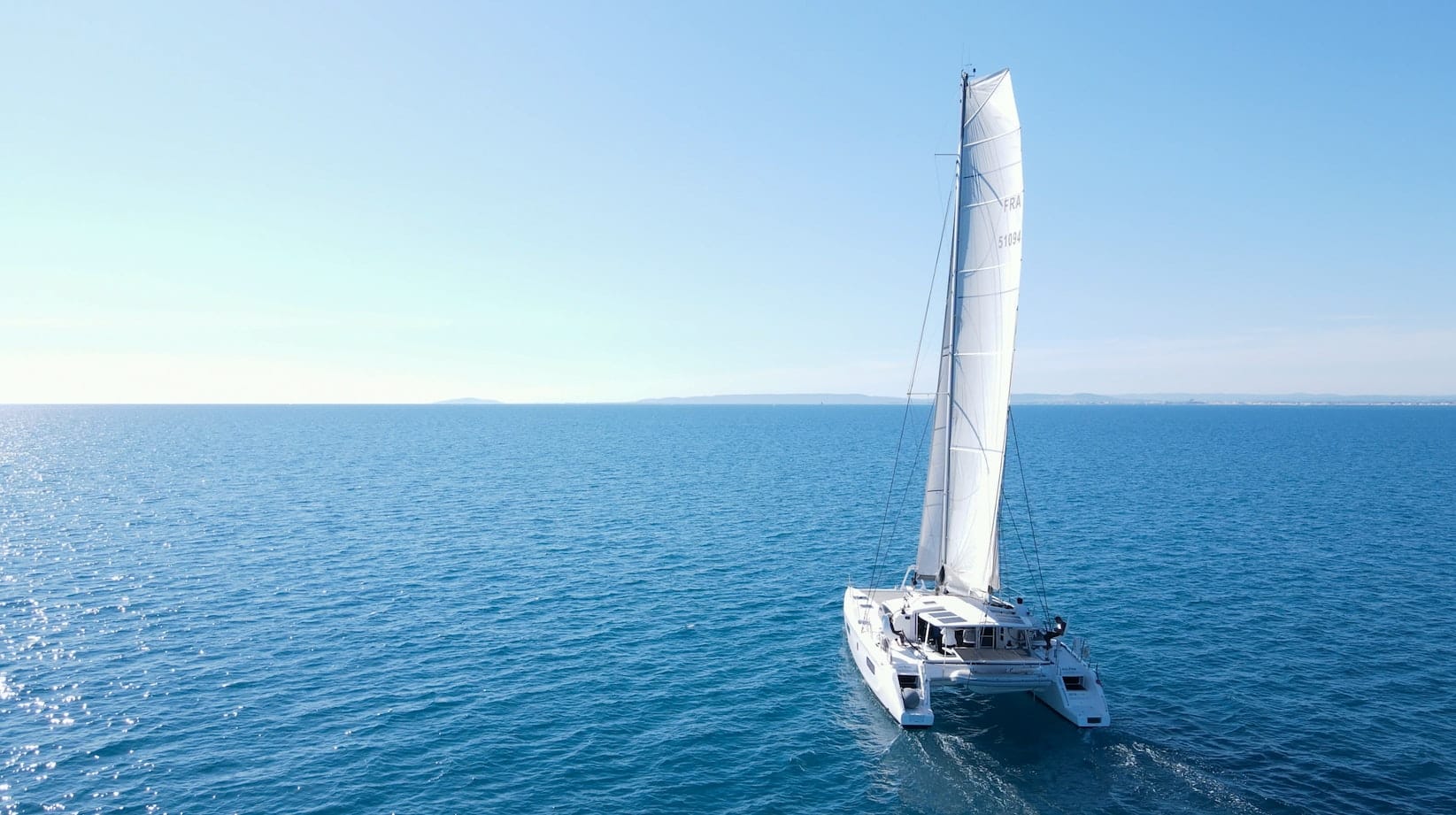
Safety at sea: adjusting daggerboards to avoid risks
This is where things start to get a little confusing.
The leeward daggerboard being down will increase the risk of ‘tripping up’. Therefore, in any significant sea state – or possible impending increase in wind/seastate such as if you are close to a mountainous shore line – where you feel that the hull is, or may, lift a lot, it is in fact safer to lift the leeward daggerboard and only use the windward one. Be aware that you will see a drop in performance as this contradicts the performance best practice of trimming the leeward board and not the windward.
The safest option entirely in very large sea states where the sea is actually tilting the boat significantly from side to side as she rolls down waves is to lift both daggerboards, so you float along waves like a raft.
‘Tripping up’ is a phrase used a lot and in fact sometimes misunderstood. To explain what it means: if there is wind/waves coming from the side of the boat and the windward hull lifts slightly in a wave, or there is a gust and the sail powers the boat forward – the leeward hull can ‘dig in’ to a wave and trip the boat up. The best way to imagine this is imagine getting one of your shoelaces on one of your feet stuck but the rest of your body is still walking. You will fall over. Same with the boat.
A converse argument to lifting the daggerboards up, is that dropping both of them will protect the underside of the boat – from grounding, or from hitting a submerged object. Having both daggerboards partially down can protect the propellor. Having them at ‘deck level’ can protect the rudder. In other words, if you hit something then it will hit the daggerboard before the more fragile underwater equipment.
Another argument against lifting the daggerboards entirely, is that with no daggerboards, your rudder is doing all the ‘resistance-work’. It is hard to believe, but it also acts as a very tiny underwater sail too. There will be a huge load on the rudder with no daggerboard at all and this risk is probably not worth the gain in speed on a long downwind ocean crossing. One way to spot if the rudder is working too hard is just look at your autopilot rudder angle – if it’s maxing out and having to work very hard to keep the boat going straight then you probably have too much sideways slip. It’s a bit like the boat is sailing on an ice rink. In that case, I’d recommend putting both of them down a touch. This will benefit both the ruder and the autopilot (therefore power consumption).
(Read our Safe Sailing article to learn more about safety on board)
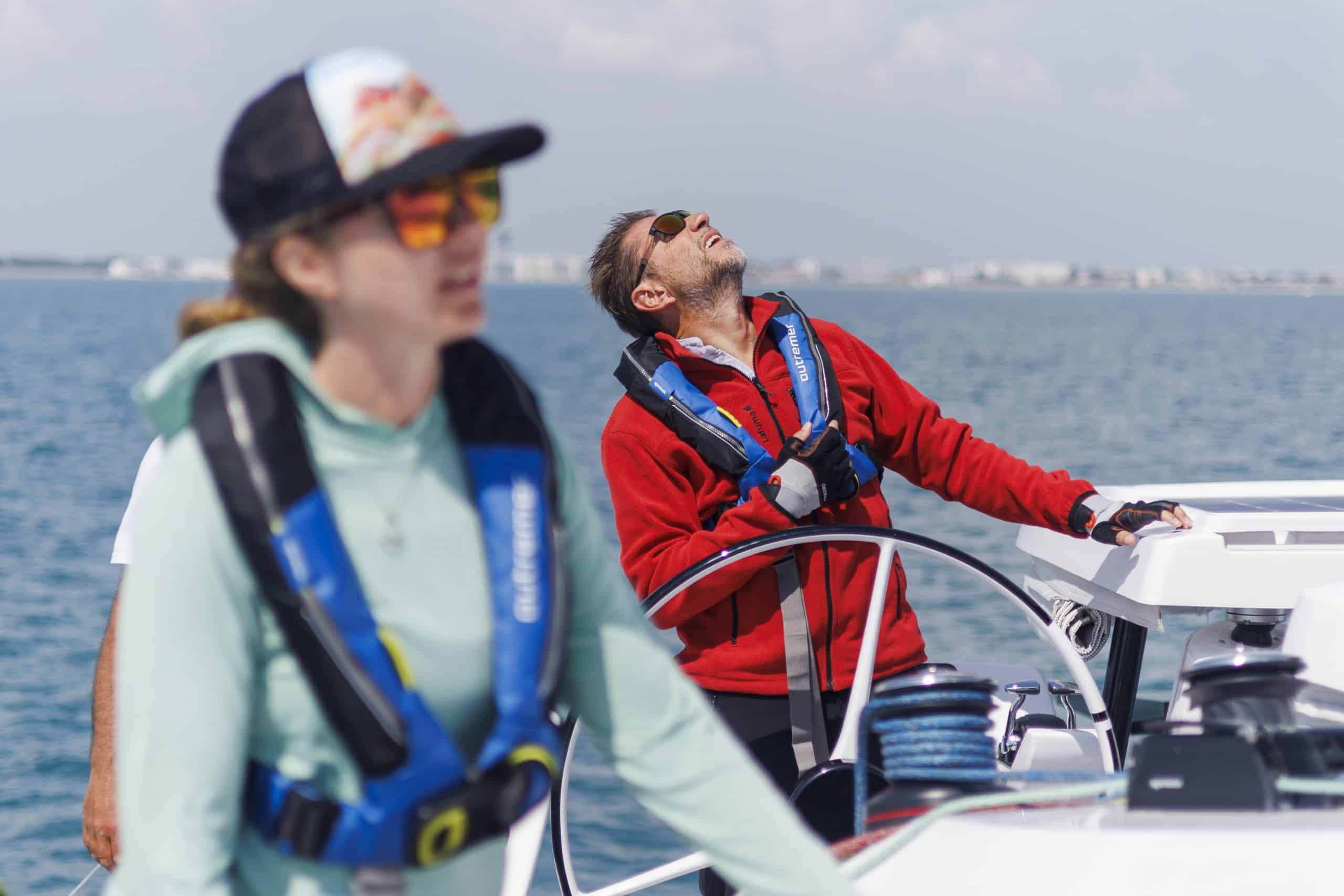
Using daggerboards is a balancing act! Boat weight, weight distribution, sail area, wind strength, sea state, sail trim are all things that effect the decision for how to use the daggerboards: how much daggerboard to use and which one (or both) to use. This is why it’s not an exact ‘one size fits all’ rule and anyone who tells you so is probably oversimplifying it which could lead to a dangerous sitaution. But start using them and see how the boat feels. The beauty of buying an Outremer is that if you keep her lightweight and trimmed well, then she will talk to you and tell you what feels good. Don’t believe me? Try sailing a brand-new Outremer out of the factory before she has anything on – then compare it to one with four peoples’ life belongings on – and you will see what I mean. 😉
Continue navigation
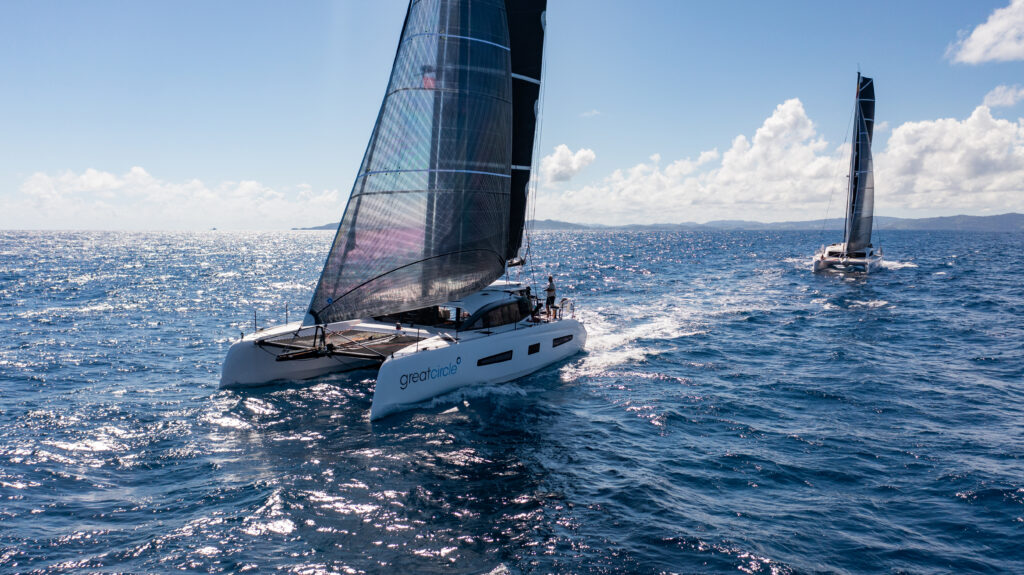
40.000 miles and 3 years to get from La Grande Motte to La Grande Motte
Marijke and Mark sail the Outremer 55 Great Circle.
Since its launch in 2021, the boat has sailed around the world with the GLYWO 500.
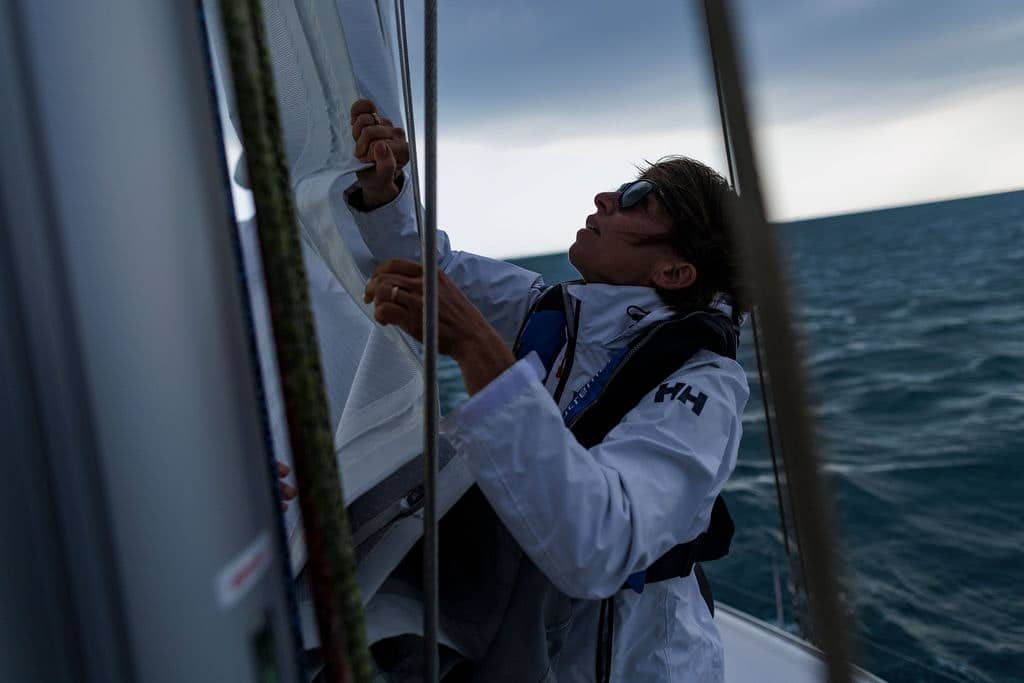
Setting off on a catamaran with the best sailing weather
When you’re getting ready to set off on a sailing trip, it’s vital to find out about the seasons and weather phenomena in your chosen sailing area. Even before choosing your cruising destination or travel itinerary, or even selecting your yacht!
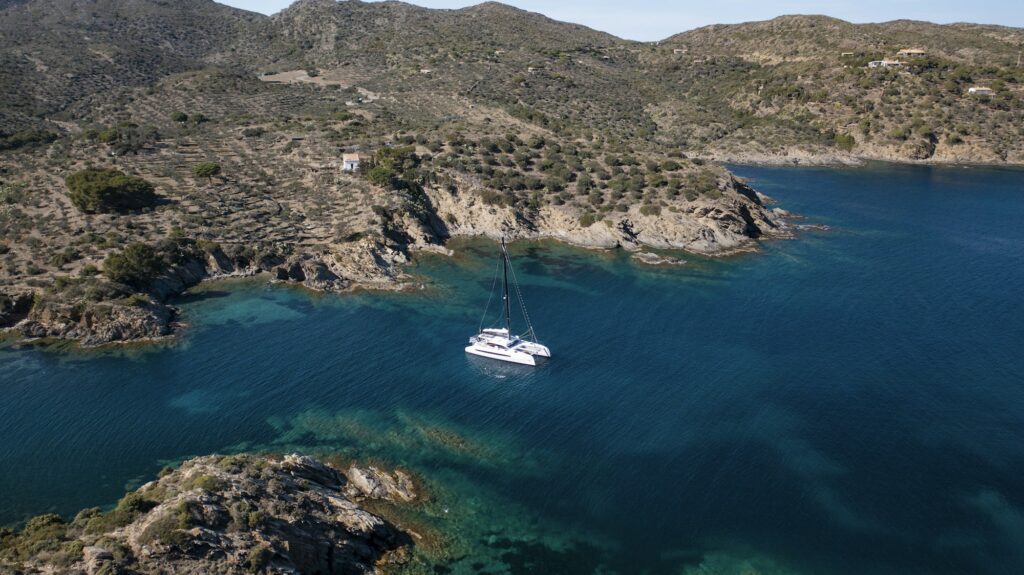
Catamaran VS Monohull: what should you choose to sail around the world?
Sailing around the world is a dream come true: you discover the world to the rhythm of the wind and the stopovers, exploring new destinations every day as you sail. If you’re just starting to read this article, you’re probably nurturing this project. Are you planning to sail around the globe? Then the choice of ship for your next voyage is crucial.

Centerboard VS Daggerboard The Differences Explained
As an Amazon Associate, we earn from qualifying purchases. We may also earn commissions if you purchase products from other retailers after clicking on a link from our site.
Sailing life entails many words that at first make no sense; in this article, I will explain the difference between two types of underwater foils, centerboards and daggerboards.
On a sailboat, the difference between a daggerboard and a centerboard is how they are moved into position. A daggerboard is lifted and raised vertically (up and down) through a slot in the hull; a centerboard, on the other hand, pivots or swings into place.
That was the short answer. There are many more commonalities and differences worth discussing, such as the differences in performance and what happens if your daggerboard hits a reef? Will it break your hull?
Keep reading to understand all you need to know about daggerboards and centerboards!
Table of Contents
Centerboard
The centerboard is mounted horizontally on a rotating bolt at the foremost part of the foil (keep reading to understand what a foil is). It folds into a comparatively much longer slot in the hull than a daggerboard.
A centerboard comes in many different shapes and sizes, it can be combined with an already existing keel, or it can be larger and be more of a stand-alone type.
How is a centerboard operated?
The centerboard is operated through a lifting line fastened at the end of the centerboard fin(board); this line is manipulated either by hand or by a winch and, once fully retracted, will be tied to a cleat.
Daggerboard
The daggerboard, on the other hand, is mounted vertically inside a sliding slot in the hull, it gets it name from the movement, much like the stabbing motion of a dagger.
The board is stopped from moving too far and falling out because the top part is wider than the lower part.
How is a daggerboard operated?
It is manipulated much like the centerboard, through a lifting line and a winch. But instead of being attached through a bolt and swung into position, it is lowered down into place.
What are the differences?
Performance.
Since the differences mainly lie in the way of deployment, there are not that many big difference, but some smaller once worth noticing are;
The daggerboard doesnt have to be either fully up or fully down; this means the sailor can adjust the depth and effects to his or her needs. To low and there will be unnecessary drag, to high and there will be too little lift and too much drift to windward.
On the other hand, the centerboard pivots into position and is only really efficient as a foil once fully deployed.
Reducing the draft of a boat is very important if you want to sail in very shallow waters such as the Bahamas or if you want to beach your cat.
What is beaching a cat?
Once retracted, there is also a decreased chance of getting stuck or tangled up in a fishing net or other semi-floating objects and sometimes hard to see.
On boats where the keel is the lowest point on the boat, the propeller will be protected, but on ships where the center or daggerboard is the lowest spot, then retracting it will make it vulnerable to damage from whales, fishing nets, or coral. You will also not be able to beach your cat since the weight of the ship will be loaded on top of your prop shaft and most certainly will break it.
Once the boards are in a fully lifted position, there is an argument to be made that the centerboard, which has a much larger slot, will have higher drag. This is true, but only if the slot is poorly design and not hydrodynamically smooth, causing underwater turbulence.
A well-designed centerboard should be able to reduce the amount of drag to the same as a daggerboard.

What are the similarities?
Both systems can be mounted in pairs and at an angle; this makes the boards work much as an airplane wing does. Once the water starts passing around it, it will create higher water speeds on the upper side, lowering the pressure and increasing lift.
This makes for less underwater surface, decreases drag, increases speed, and fuel efficiency.
One issue often discussed on forums and with boat people is that a centerboard is safer since if an underwater object hits it, it will fold back into its slot, and no damage will be done. This is true to a degree but worthy of some explanation.
Firstly this is mainly a theoretical argument since an object is not certain to hit the board from straight on; this means that the idea of folding is no longer possible. The next thing to understand is that daggerboards are made to break; this is a safety aspect and makes sure that the hulls stay intact and that the boat will stay afloat.
This is similar to modern mini keels on catamarans; they too are constructed to detach if hit hard enough, the keels fall off, but the hull stays intact.
Both systems offer a risk of getting stuck; some say this is a bigger issue with daggerboards, and they more often fail than the centerboard style. This is not something that I have been able to confirm through any data, and looking at the design of newer daggerboards; there is no real reason to think that this should be the case.
There are many different systems on a sailboat, and everything that can move will sooner or later stop moving due to rust or being filled up with salt and sand. So will too these boards; this means extra time for maintenance and extra money to be spent keeping the systems in good shape.
Compared to each other many would argue that the centerboard is a somewhat simpler system and that they need less maintenance; I would say it is more up to the specific design than whether or not it is a centerboard.
Catamarans and Monohulls
The basic function of a foil is the same whether you’re on a catamaran or a monohull, although some aspect is specific for a cat.
A catamaran will always have two boards; these can be used together or separately. Since a catamaran behaves very differently in big seas than a monohull, the use of foils, especially during heavy weather, is essential to understand if wanting to stay safe.
One situation when catamarans can capsize is while being pushed horizontally by a big breaking wave hitting it from the side. If both boards are down, this will decrease the possible sliding motion and therefore increase the likelihood of capsizing.
This is a complex issue and if you want to undestand capsizing in detail i suggest you read this article;
Why do catamarans capsize
Owner of CatamaranFreedom.com. A minimalist that has lived in a caravan in Sweden, 35ft Monohull in the Bahamas, and right now in his self-built Van. He just started the next adventure, to circumnavigate the world on a Catamaran!
Leave a Reply Cancel reply
Your email address will not be published. Required fields are marked *
Save my name and email in this browser for the next time I comment.
Recent Posts
Must-Have Boat Gear for Catamaran Sailors!
Sailing is probably the most gear-intensive activity I've ever done; there are so many decisions to be made about what gear to buy now, for tomorrow, and what to definitely never buy. The gear on...
6 Best Trailerable Trimarans For Bluewater and Coastal Sailing
Having a boat costs a lot of money, even when you are not using it, marina fees, etc. And once it is in the water most sailors never go very far from their "home marina" and sailing will be somewhat...

Which catamarans have daggerboards?
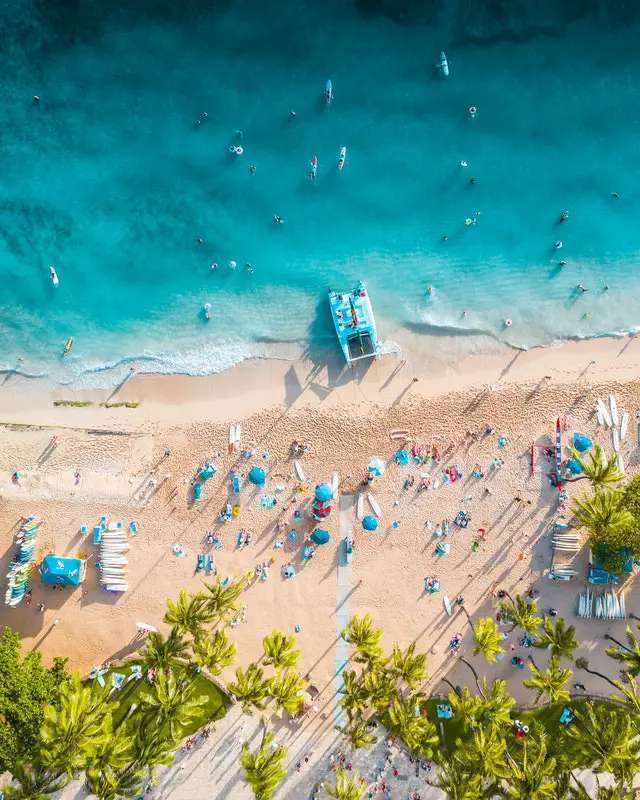
After researching catamarans we have made a list of catamarans with daggerboards. Performance means a great deal for us, so we are looking at the pros and cons of daggerboards, and would like to share our knowledge in this article. If you know of any boats that should be included in this article, please let us know.
Why choose a catamaran with daggerboards?
Daggerboard catamarans are usually higher performing than those without. Not only because of the daggerboard itself but due to the specific focus on performance especially in these types of vessels.
Usually, that focus also makes them lighter as the shipyards have tweaked the materials used to make them light. Often they are designed by the most renowned experts to make the best hulls.
The most important reason to choose daggerboards is performance. They sail closer to the wind when sailing upwind, and they are usually faster than those who focus more on comfort.
Not that daggerboard cats are uncomfortable, but the daggerboard compartment takes up a bit of space from the living area inside the hulls. And you will have to decide if it is worth the decrease in comfort compared to the enhanced performance.
Another reason for choosing daggerboards is the possibility to anchor on shallow waters, as when the daggers are lifted, the draught is often around 3’ or 1 meter or even less.
Catamarans with daggerboards
A list of catamaran models with daggerboards:
- Sud Composites
- Soubise / Freydis – Tournier Marine
French-built catamaran. Well sailing and luxurious.
Also French catamaran. Reviews are pretty good. Easy sailed.
Brazilian built catamaran from 2013. Only this model has daggerboards.
designer Philipe Pouvreau. 30 of them were built before 2008, and after that, a dozen more were built in various custom shipyards. One should therefore be aware of eventual modifications or deviations in the design of the later models.
But the quality is still great, also on the late models, and they have successfully circumnavigated, and are still.
Founded by Alan Adés in 1990, and in 1999 they signed with VLPL, a group of Architects who specialized in multi-hull designs for the competition.
This resulted in the Switch 51, a very well-performing catamaran, which amongst others are known for very decent speed in even moderate wind speeds. They did however not build that many, before switching to building custom catamarans.
Three main models, are still in production:
Soubise 49 Croiseur Soubise 56 Soubise 70
Is not very well known, 27 feet
- Scionning Known to be very high performance.
Benefits of having daggerboards on a catamaran
High performance (speed and efficiency in various wind directions. Especially in upwind directions.)
Can utilize shallow waters, with the boards raised. Typically 3 feet or even less, which means that you can anchor away from the crowd and walk ashore.
Generally, you will have much more anchorage space to choose between.
Disadvantages of daggerboards
More work, more to know and learn, their place in the boat may limit the comfort.
Costly. Adds around 30.000 $ to the construction price.
Why choose daggerboards over fixed keel?
The choice of having daggerboards is mostly a compromise between comfort and performance. Daggerboards make the cat able to sail closer upwind, and the boards are made to enhance the speed.
Boats with fixed keels are sometimes slower, usually also heavier, but also more comfortable, as they have more living space. And if you are sailing short passages, the heavy boat is a good choice.
But if you are going to cross the oceans, the difference in performance is remarkable. It can be several weeks longer crossings compared to higher performing cats.
Daggerboards are for sailors who expect to make longer passages, and who have some experience sailing.
Related Posts
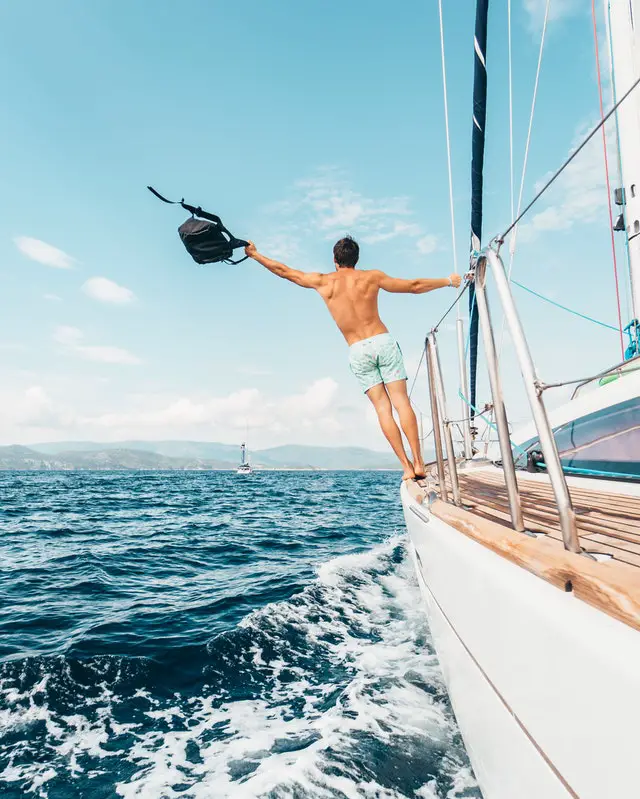
Should you own or charter a boat?
I could give you many reasons why not to buy a boat, but they would be the same reasons not to have a child. Unknown…
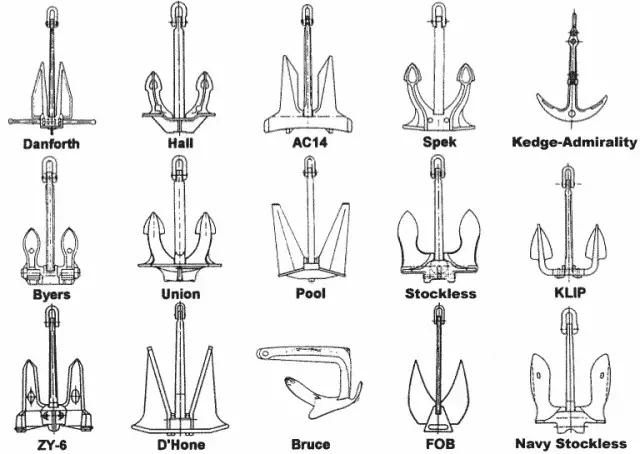
How Anchors Work and All You Need to Know about Anchoring
In this article, you will not only learn all the basics about anchors. You even get all the more advanced knowledge you need about how…
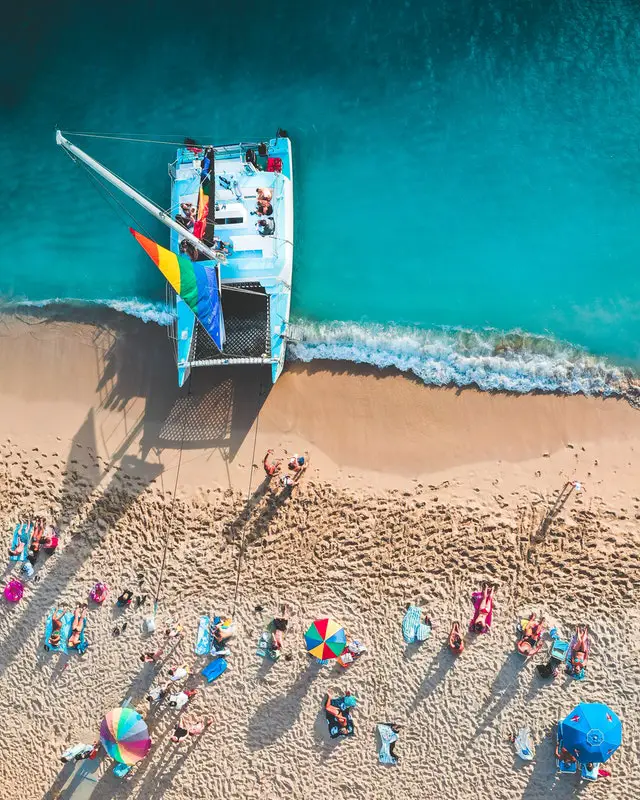
Why catamarans have trampolines
There are several reasons why trampolines are the right choice in catamaran design: It is lightweight, give little resistance to wind and water, is comfortable,…
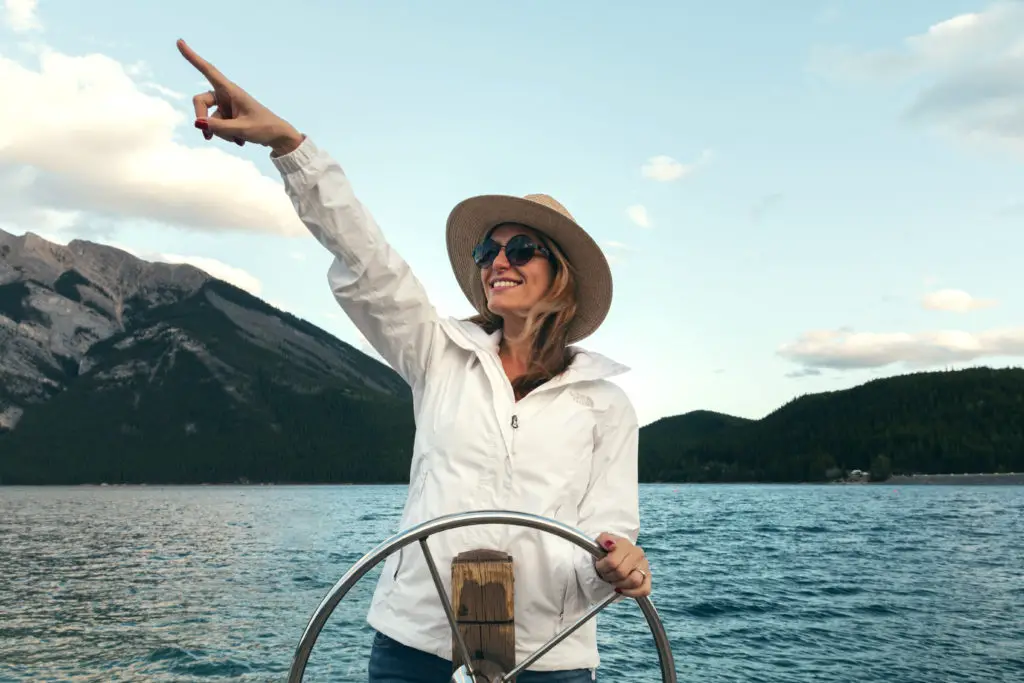
Tips for new sailors in 2022
Are you considering taking up sailing, then you may wonder if sailing is a dying hobby? In this article, we would like to answer some…

- About Aeroyacht
- Aeroyacht Design
- Aeroyacht TV
- Mission Statement & Privacy Policy
- Aeroyacht Racing
- Favorite Links
- Customer Testimonials
- Office Location
- BUY A MULTIHULL
- Specifications
- Photo Gallery
- Try Before You Buy
- Yacht Ownership and Demo Sails
- BUY A POWER CATAMARAN
- Yacht Business Ownership FAQ
- MULTIHULLS FOR SALE
- Aeroyacht Superyacht Catamarans
- Global Multihull Search
- Buy A Multihull
- Sell a Multihull
- Multihull News
- Publications & Articles
- Commissioning & Delivery Services
Multihull Keels and Daggerboards

Fountaine Pajot BELIZE 43 resting on her keels, showing good bridge deck height
Uncovering the compromises of both underwater appendages and analyzing their disadvantages and merits.
Man has learned much from nature, and sailboats and their underwater appendages are one of the areas that we have applied what works and what doesn’t. As we all know, boats – as most things in life- are compromises and often we are prepared to make concessions in one area in order to gain an advantage in another. Not only should this brief discussion illustrate the basic virtues and drawbacks of daggerboards and mini keels on multihulls, but also point out their active and passive safety aspects.
Most multihulls in todays marketplace come in two varieties. By far the vast majority of the production cruising catamarans (about 90%) are keelboats and have low aspect ratio, unballasted keels. These well known French, Australian or S.African boat manufacturers market their boats for private ownership and the charter industry and make a great product. Without sounding too general, these boats have very spacious interiors and are perfectly adaptable for live aboard families or the charter trade. This multi million dollar charter industry, has an obvious influence on the requirements and design of their charter fleet, which further has a trickle down effect to other builders who also market their cats for private ownership. Design parameters for these charter cats are often centered around 2 week multiple family vacations in the steady Trade Winds and day sails between closely spaced islands of the Caribbean. The features of these keel catamarans obviously put less demand on pure sailing performance or extreme upwind sailing characteristics, but rather try to please by offering solid construction, live aboard comfort and simple and reliable handling characteristics.
The other type of multihull is the catamaran with articulating daggerboards or centerboards. Centerboard and daggerboard multihulls both share the same basic concept, except their deployment and storage relies on different principles. The daggerboard lives in a scabbard, or daggerboard trunk. It moves up and down, vs. a pivoting centerboard, which is raised and lowered around a massive pin. High aspect ratio daggerboards are by far the most efficient foils. They have none of the problems associated with centerboards, which when fully lowered are only braced by a small area on top. When going upwind in a hurry, loads on the trunk act as a giant lever, which constantly work to spread the trunk apart. This is the reason why it is recommended to operate foils as pairs in heavier conditions to divide the loads. Also the large area of the remaining centerboard slot creates a lot of unwanted turbulence making them unpopular for performance minded sailors. Lastly declining popularity of the centerboarders can also be lead back to the often large intrusion on the interior space the trunks create. Although the Gemini catamaran is a good example of a very popular and well thought out production catamaran, there are few other mass produced centerboarders around. It should be noted that one great advantage centerboards have vs. any other underbody configuration is that they theoretically retract when colliding with an object. In spite of this, most offshore or performance orientated sailors clearly favor daggerboards or low aspect ration keels.

Illustration A
Daggerboard catamarans have several advantages over their keel counterparts, some of which are well known and others that are more subtle and sometimes only recognized by people who have used them. Active safety aspects are advantages created by speed and the ability to retract underwater appendages.
I am a firm believer of “faster” rather than “slower” on ocean going performance multihulls. Many people might say, going fast is only for racers. But lets think about this. The ability to reduce exposure time through speed is invaluable for cruisers. If say on a transatlantic passage you can shave off 5 days you have already increased your safety factor, in some cases, by 25%. Not being a “sitting duck” is a nice thing indeed. By being able to have the choice, bad weather can be avoided, which can sometimes lead to a negative spiral of incidences. In general, especially on long passages, a daggerboard cat will have the edge on speed over her keel counterpart.
Lets face it, we are all in it for the fun of sailing as famed designer Francis L. Herrshoff said: “The fun of sailing is directly proportional to the speed of sailing”. Maybe this is the reason he designed Amaryllis, his revolutionary catamaran, which was later banned from racing. Generally speaking daggerboard catamarans will always be slightly faster than their keel equivalents. The speed advantage of most daggerboard catamarans vs. keel catamarans though is often exaggerated. On a typical day sail a well trimmed and tuned keel cat will only be slightly slower than a daggerboard cat.
Multihulls lack the feeling of being in the “groove”, which monohull sailors enjoy. Effortless high average speeds, acceleration and sustained high velocity surfs is something fast multihulls compensate with. It should be noted that anything (even a barn door) surfs in the right conditions. Even keel catamarans can surf at speeds up to 30 knots down large seas.
Upwind Advantages: Depending on sea state going upwind, daggerboard catamarans vs. their keel relatives will point up to 5 degrees higher and also experience 2-5 degrees less leeway, which isn’t much one would think. But in an uncomfortable 100 mile beat this ads up to being more than 17 miles closer to your destination! (Illustration B).

Illustration B
sin A=a/c (sin A) c =a (0.1736) * 100 = a a = 17.36 miles
Lets take a 45’ catamaran: the lift (to windward) generated by a daggerboard is almost twice that of a low aspect ratio keel and the drag with the board all the way down would be almost 20% less. The most recent generation cats with large beams and stately bridge deck houses benefit especially from high lift foils, since the windage of their projected area can ad up quickly. The same cats with keels usually suffer from excessive leeway and sideslip. Keel cat’s however, especially in a calm sea state, lessen this disadvantage as boat speed and flow over their keels increases.
Reaching and Running Deep: When running deep in fresh conditions the fixed could act as a brake, that one cannot disengage. Since they cannot be retracted, their volume and resistance slows the boat’s progress and in combination with the forward pressure of the sails forces the bows down. This is especially the case with catamarans that have long bridgedecks, heavy extremities and low volume- fine bows. The bigger the friction in the water, the bigger the pressure on the mast and the more the boat is burdened. Another neat trick is lifting the daggerboards, one can actually increase apparent wind by pointing up and induce leeway, crabbing faster to ones destination.
Tacking and Helm Feedback: Cruising catamarans are often mistaken to tack slowly and behave sluggishly to movements of the helm. This is certainly true for some heavy keel catamarans and much less so for ones equipped with boards. In complex seas, some of the heavier keel cat’s only option for a safe tack is back winding the jib. Monohulls with only one fin will always tack quicker than multihulls, just as foil equipped catamarans will be more responsive than keel multihulls. Modern hydraulic steering systems are easy to build and with most forward helm stations behind the main coachroof, pose sometimes the only alternative for the builder. Mechanical steering and daggerboards will give the ultimate feedback and fun at the helm…if one is driving at all, since usually the autopilot is engaged for longer legs.

Inclined foils on the Aeroyacht H42 performance catamaran built by Edel
Another advantage of daggerboards is the better maneuverability under one engine. If you loose one engine and retract the board on the hull which has no engine power, but leave the powered hull’s foil down, the boat will turn easier. Because of the retracted foil on the un-powered side there will be much less drag induced turning moment, the boat will be more balanced and the other sides deployed board will provide sufficient bite for “survival” steerage. Especially in high crosswind situations a catamaran with both boards down is much easier to maneuver than one with shallower keels. Usually harbor maneuvers under power are low speed operations, and this is where the high lift capacity of twin boards excel yet again and facilitate handling and precision steerage. Daggerboard cats also can motor a bit faster, since by retracting the foils they have less resistance.

Keel and daggerboard cats usually have less draft than keel monohulls, opening access to shallow anchorages. An advantage daggerboards have, are their gauging characteristics when entering shallow harbors or unknown territory. By lowering them, one actually creates a “safety depth”. When they touch bottom one still has the possibility of raising them, performing a U-turn and getting into deeper water. With fixed- non retractable keels, especially with a monohull, groundings or unplanned bottom encounters could end tragic. At least a monhull can attempt in heeling the boat to reduce draft and re float. This obviously is not an option on a keel cat. If you get stuck in the mud you are dedicated to await the next high tide to get you off. Crashing into a coral reef could be a different story altogether and only a haul out can asses and repair damage. Depending on their design, boards could be rotated or flipped, and even repaired underway. In general daggerboard cats also have less draft than keel multihulls allowing access to even more harbors and anchorages. They can be beached high up for repairs or inspections, increasing the window of exposure time between tides. I know, I once performed a 5 hour long emergency repair on our 43’ catamaran this way, saving 1000’s in yard bills and days of headaches.
It should be notes that keel catamarans however, can be beached just as easy as daggerboard cats. They can be left sitting, high and dry, completely safe on their keels, without having to worry about damaging the hulls or getting debris or sea life stuck into the vulnerable daggerboard trunks.
Bruno Nicoletti is an old friend and one of the most low key-expert sailors I know. He has logged more than 130,000 miles (geriatric miles as he calls them) on his 44’ daggerboard catamaran.. At a recent meeting with him in France we talked about his experiences of his record, double handed – one stop- Southern Ocean circumnavigation at age 63. The French Press compares Bruno to sailing legend Vito Dumas and has published his accounts in an article called: “The Impossible Route”. He explained, that in the Southern Ocean, in the most convoluted conditions he would simply raise both boards, lock the helm to windward and lay a-hull with no sails. “Brumas Patagonia” would safely slide down the steep faces of waves and minimally drift to leeward at about 1 mile per hour while he was either resting or reading. The water spoil of his side wards drift would help keep the edge off cresting waves and often prevent them from breaking (Illustration D) While it was blowing 70 knots and higher he felt very safe and in fact the world around him turned peaceful and quiet. His confidence in this system is impressive: I am currently helping him with sea trials on his new 47 footer for a yet another go at a High Latitude – geriatric- circumnavigation. This time he is planning to take his 78 year old brother and do it non stop !

Illustration D
It is not only in the Southern Ocean that one encounters steep, breaking waves. Major capes or the Gulf Stream are notorious for rough conditions where the ability to navigate safely becomes imperative. In these environments any proven and strongly built daggerboard cat would have a slight advantage by lifting her boards, although a well designed keel catamaran could get through unscathed. In extreme weather, and I am talking beyond Force 10, it is very important to enable a catamaran to side-slip rather than encouraging the possibility to trip, and maybe flip. A catamarans behavior in towering side waves is decisive and the possibility to lift underwater appendages is essential, especially if one has lost the ability to steer. The disadvantage of a keel catamaran in huge beam seas is more psychological than real, as these types of vessels typically also slip sideways. In survival conditions or emergencies, the use of parachute anchors, which force the boat into a certain attitude is often thought to be the only answer for most boats. In my mind this tactic is questionable since it puts enormous strains on the boat, is accident prone and renders one helpless when the odd rogue wave from a different direction smacks into the boat. It is better to manage survival conditions, by controlling and slowing the vessel with the use of drogues.
We have learned a great deal from aerospace industry and the trickle down effect to monohull keels. Multihull designers and builders greatly profit from the advanced research, that has been done in the field of NACA sections (National Advisory Committee for Aeronautics) and foil performance. Keels and daggerboards come in a variety of aspect ratios but most are based on low speed foils, which drag/lift characteristics have been optimized. To increase lift even further, some performance catamarans even utilize asymmetrical shaped daggerboards, shaped flat on the outside (leeward) and cambered on the (windward) inside. As they can only be used one at a time asymmetrical boards are somewhat limited in their adaptation for cruisers. (Illustration E)

Illustration E
Since multihulls do not heel, their underwater appendages are more effective in retaining positive flow than their monohull relatives.(this is also the reason why autopilots burn out less often and can be used in heavier conditions on catamarans) As the monohull heels, not only is the upper part partly blanketed by the underbody of the vessel but also flow is lost as the water slips past the angled keel to leeward. (Illustration F) This was especially prevalent on the early IOR monos, which had extremely beamy and shallow bilges and high prismatic coefficient center sections. To compensate for this loss of heel induced flow, monhulls need deep draft keels to make good progress to windward. The keel or daggerboard catamaran on the other hand can more efficiently create lift for the same keel plan view area, not only because it has two vs. one keel, but also through its minimal heel is able to keep its underwater appendages perpendicular in the water.

Illustration F
Usually catamaran daggerboards have a higher aspect ratio and are deeper than the equivalent length monohull, since they have the ability to retract them and therefore have no draft considerations. It is therefore not surprising to see that in wind speeds starting at around 10 knots a well designed and sailed daggerboard cat, will often outpoint and outpace a performance monohull. Even well sailed keel catamarans can often arrive earlier at an upwind destination compared to heavy monohulls. The couple of degrees they sacrifice in their ability to point to windward is often made up by their higher speed and VMG (Velocity Made Good). This performance difference increases proportionally to the wind speed and is very noticeable in F.4 conditions and beyond.
A well known fact and possibly the single biggest psychological deterrent of daggerboard cats is the vulnerability of the boards and trunk in collisions. The true Achilles heel are actually ill constructed and designed trunks, which cause flooding in an impact. This obviously is not the case with keels, which would deflect a minor obstacle, or in case of hitting a container or whale, simply break off. In the case of sacrificial keels, they would sheer leaving the hull completely intact.
Obviously the most critical area in daggerboard design is the construction of the daggerboard trunk. It is usually heavily reinforced with massive gussets, especially at its aft bottom end and extends from the bilge to the overhead. Typical forces on the trunk easily exceed the pressure of the wind on the sails. Dynamic forces of wave action and the shock loads of slamming into seas or solid objects must make this area one of the strongest and best engineered of the entire vessel. Usually the foils are located just aft of the main- mast bearing crossbeam and are somehow tied into this unit to profit from its stiffness. The more “left over” daggerboard remains in the scabbard in the fully down position, the better it is braced, so it is not surprising to see foils that are 18’ long for a 60’ boat. Builders who take their job seriously go through great lengths to make this key area as strong as possible. In a recent conversation with the manager of a reputable French production yard it was pointed out that the daggerboard trunk is engineered and constructed 7 times stronger than the composite board. In case of a violent impact, the foil, which has weak spots designed into it, will snap and leave the daggerboard trunk unscathed. It is a type of sacrificial impact philosophy or a safety fuse, just as it is used on sacrificial fixed keels. The careful engineering and experience necessary in building reliable daggerboard or keel cats stresses the importance of a production yard, which has consistently built them. This aspect should not be taken lightly if one ventures out into the open sea, even if it is only 20 miles offshore.

Often builders of keel cats ad daggerboards to their designs, with the objective to market increased performance and safety. This usually ends up in a compromise, since the hydrodynamic hull requirements of both types could differ substantially, let alone the experience of proper integration, engineering and construction might be lacking altogether. Building with keels does not require the experience, careful construction and engineering which are necessary with retractable foils.
Keels offer advantages, as they do not need to be operated at all. They do their work silently and its usually one less thing to go wrong. On the other hand people who have never sailed with daggerboards think their operation is complicated. In fact they are as easy to use as outhauls or travelers. In normal conditions with 2 people – one pumping the daggerbaords up haul line directly at the board- the other taking up the slack of the up haul, it literally takes 3 seconds to raise a 15’ daggerboard. Single-handed it is a 10 second affair involving 2-3 wraps of the up haul around a winch and 10 cranks. Most boards are slightly heavier than the water they displace and often only weigh 80 lbs. Dropping takes half a second, by simply opening the up haul sheet stopper and easing the foil down. Loads on the boards increase as the speed and pressure builds, so if one has the choice, these maneuvers are usually performed just before tacking. It is a misconception that the operation of foils will depend on the wind speed. It is rather the boat speed, in regards to sea state – which in turn limits progress – which dictates the proper positioning of the daggerboards.
Nothing is perfect and this analysis would be worthless without mentioning the pro’s and con’s of either underwater appendage. Daggerboards, their surrounding structures and systems are more expensive to build, so builders prefer to stay away from them given the choice. In some catamarans, especially smaller ones or ones that have the trunk in the center of the hull, the interior passage in the hulls can be crammed. Lastly it should be mentioned that incorrectly designed and constructed, daggerboards multihulls can be more of a detriment than virtue and in some cases can be extremely dangerous. If the trunks are not massively reinforced and in case of a violent collision one could flood one hull and cause a capsize. In this case one is better off with a well designed and constructed keel multihull than a mediocre or untested one with daggerboards.
Yet daggerboards give you choices, that keels deny you. It is like the new generation of cars with Tiptronic gearboxes, which offer you an automatic transmission with manual override. By physically selecting the proper gear, torque can be adjusted to suit the conditions. It’s the same with the daggerboard equipped catamaran. The boat can be fine tuned to optimize the level of efficiency of the vessels motion through the water. By being able adjust the foils, superior sailing characteristics result in speed and generally more fun on the water. Active safety aspects of reduced exposure time, better maneuverability and shallow draft provide significant benefits.
For safety reasons, most catamarans builders opt for fixed keels and completely separate the keels from the hulls, a feature which preserves and protects the water tightness of the boat in the event of violent impact. Furthermore, if such a situation arises, it makes them easier to repair or replace. Fixed keels require no manipulation, such as daggerboards and give perfect protection to drive shafts, propellers, rudder blades and hull bottoms in the event of grounding. Lastly the absence of a centreboard case means saving of space in the interior of the vessel and usually results in a larger living space.
Back to the birds. We all know the giant Albatross as an extreme example of a sorer that can glide for days in varying conditions, without having to move its wings. This Southern Ocean beast, who calls his home the most inhospitable area on our planet, is better adapted to handle extreme circumstances than any other flying animal. The Albatrosses’ wings are sophisticated in shape, but basically are articulating high aspect ratio foils very similar to daggerboards. Similar to the Falcons “high speed” wings, the Abatross can modify its wings aspect ratio to adjust to the breeze. The designers of the Polynesian multihulls, legendary Viking long ships and American Cargo Schooners understood this too. By adding movable leeway devices, center- or daggerboards, they made their boats more seaworthy and even sailors in the past preferred them over fixed keels.
Today we continue to strive to find the perfect compromise in our vessels to satisfy our most important requirements. We should be extremely thankful to the 1000’s of keel multihulls that have revolutionized the charter industry and many good boats have evolved from this trend. Reputable dagger board catamarans and well designed keel multihulls will continue to be the choice of future generations of serious offshore voyagers. Both offer their advantages and disadvantages and it is important to understand both in order to make the proper choice.
Gregor Tarjan, a trained naval architect and longtime multihull enthusiast is writer of numerous articles for Multihulls Magazine and various other trade publications. He has been involved in Dennis Conner’s “Stars and Sripes” 1984 Americas Cup Campaign, is the founder of Aeroyacht.He is also the co-editor and contributing author of the “Sailors Multihull Guide”, the book by Kevin Jeffrey.
Social Share
Catamaran news.

NEEL 43 “PERFORMANCE” Version – a special Limited Edition Trimaran

NEEL 52 Trimaran – Immersive 360 Experience

Newest photos of the McConaghy 75 catamaran

Free Multihull Charter before you Purchase

NEEL Trimarans Owners Community
- Catamaran Steering Positions
- Catamarans vs. Monohulls
- Catamaran Learning Center
- Catamaran Speed
- Catamaran Efficiency
- Catamaran Stability
- Catamaran Safety
- Catamaran Shallow Draft
- Catamaran No Heel Sailing
- Catamarans and Seasickness
- Catamaran Space
- Catamaran Boat Handling
- Catamaran Advantages over Monohulls
- Wave-Piercing Bows
- Catamaran Sailing Schools
- Catamaran Insurance
- Catamaran Charter Business and Tax Savings
- Ask the Owner
- 5 Valuable Tips
- Survey Checklist
- Sea Trial Checklist
- MULTIHULLS & CATAMARANS App for Iphone
- Catamaran Surveys
- Multihull Services
- Catamaran Build Consultation
- Financing Services
- Catamaran Repair & Service Facilities
- Catamaran Demo Rides & Shows
- Catamarans for China
- Yacht Design
- Interior Styling & Yacht Art
- Photography

Nautitech 46 Price Drop
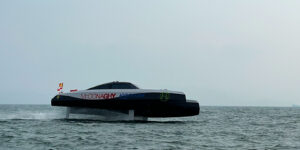
McConaghy Chase ZERO Hydrogen Powered Yacht

McConaghy Multihulls Nominated for Design Award – McConaghy 75 and MC83 Power
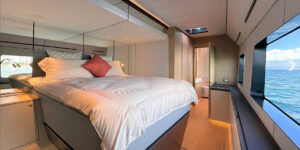
The Stunning Interior Design of the McConaghy Multihull Range

Nautitech Spareparts – Order Simple and Quick
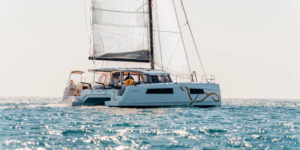
For Immediate Delivery – Nautitech 44 Owner Version
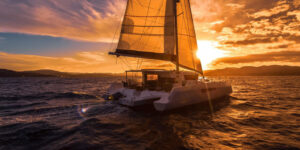
Yannick Bestaven’s NEEL 47 Trimaran

Conser 47/50′ FOR SALE

Planet Sail tests a McConaghy Multihull
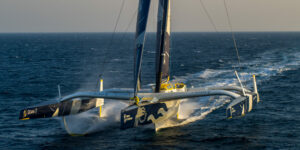
Charles Caudrelier wins Arkea Ultim Challenge
Helpful tips from aeroyacht.
AEROYACHT PUBLICATIONS
Catamaran books by gregor tarjan.

JOIN AEROYACHT’S NEWSLETTER
production Strider 24
plywood Romany 34
lightweight 14ft Zeta mainhull
Strike 15 trimaran at speed
28ft Skoota in British Columbia
10ft 2 sheet ply Duo dinghy
24ft Strider sailing fast
36ft Mirage open deck catamaran
- All Our Designs
- For new visitors
- About Richard Woods
- Useful Articles
- Testimonials
- Year Reviews (1998-2014)
- Plan Updates
- Links to Owners and Suppliers
- Consultancy Service
- Boats for Sale
- Blog and Facebook Posts
- Our Cruising Blog (updated Jan 26th 2020)
- Download Eclipse logbook (300 page pdf)
- Download Newsletters 1992-2002 (pdf)
- Download Year Reviews 2002-14 (pdf)
- Download FAQs (pdf)
- Download Boat Tests (pdf)
Keels or Daggerboards, the pros and cons
When writing about foils (ie boards, keels and rudders) it is easy to baffle people by talking about lift to drag ratios, NACA sections, end plates, twist, stall, Karman vortices and all the rest. So I won't - it's probably best to leave all that to designers and hydrodynamacists Instead I'll try to help those who want to know the basics; like should they have keels or boards on their multihull?
I'm not just a multihull designer; I'm also a (home) boatbuilder and owner. Currently I own two catamarans, one with daggerboards and one with keels. Over the last 30 years I have owned five cruising catamarans with keels, nine with daggerboards and one with one centerboard. Furthermore, I am one of the few designers who has fitted LAR keels and boards to the same hull (on Strider, Sagitta and Banshee) and then sailed them against each other.
As with everything to do with yacht design, leeway prevention is a complex subject. And it is not helped by the fact that boats are not just for sailing. You load them down and treat them as a floating cottage when you live aboard them. You motor them, you dry them out (either when the tide goes out or when stored ashore in a boatyard). And you have to pay for it all.
===========================
First a bit of simple theory
The main factor determining the efficiency of a foil is its "Aspect Ratio" (AR) or the ratio of it's depth to width. I think we all know that a high aspect ratio foil is more "efficient" than one with a low aspect ratio. A 3:1 AR is generally considered ideal for rigs but is usually too high for foils. In fact a 1:1 AR is OK for keels, although 2:1 or a bit more is better. In other words, a 1.5m deep daggerboard on a 10m boat will be about 750mm fore/aft (or more properly called it's "chord"). And it will be about 75mm thick, as the thickness of a foil should be about 8-10% of the chord.
Despite the fact that high AR foils are more efficient, there are a couple of reasons for limiting AR. As the AR increases the chord decreases and so the foil becomes thinner and clearly it is then also weaker. Unfortunately the foil loads have gone up (because the deeper the foil the further the Centre of Lateral Resistance (CLR) is from the bottom of the hull, so the lever has lengthened). So long, narrow foils are more prone to damage (one reason all those monohull keels have snapped off - a J800 lost one just recently).
In addition, the higher the AR the easier it is to stall the foil. When a foil stalls it stops "working", this is most obvious after tacking in a sloppy sea and you find that the boat won't sail properly for a couple of boat lengths. That is because the foil has stalled. In other words, you have to be sailing in flat water and be a very attentive helmsman to avoid stalling a high AR foil.
The lower the AR the bigger the foils area has to be to compensate for the reduced efficiency, however a lower AR is more tolerant of shape, surface roughness and angle of attack (which basically makes it easier to sail)
So how big should a foil be? Roughly 4% of the sail area is a good starting point. Some designers use very small boards. That may be OK in theory, which says that you sail in flat water at maximum speed, but in practice I find you need a bigger board to cope with waves and slow sailing, never mind tacking in a lumpy sea.
Whilst on the dangers of too much theory. Many race boats use sophisticated shapes and low drag sections. Don't use them unless, like top racing boats, you also dry sail your boat. Only the simplest shapes work with a rough surface (even new, clean antifouling is considered rough), these fancy shapes need a smooth, ie a mirror finish, to be of benefit.
I definitely don't like asymmetric foils. True they may give a bit more lift but only one can be used at a time, the other HAS to be raised. So you are carrying around the extra weight of a second board and box plus wasting time adjusting boards after each tack which all makes it not worth the very small efficiency gain.
Many people, especially cruisers, don't mind compromising on performance if it means an easier life, more load carrying and greater protection for the rudders and propellers. And that is why Low Aspect Ratio (LAR) keels are so popular. In much the same way as monohull sailors buy a long keel boat rather than one with a fin keel.
Unfortunately, using LAR keels results in a slower boat and more pitching. That is because to optimize speed you need a hull with buoyancy in the ends, not in the middle (technically you need a high Prismatic Coefficient - Cp). Clearly adding a LAR keel adds buoyancy in exactly the wrong place. Furthermore the midships buoyancy makes the boat pitch more as the hull is more "diamond-like". Having said that the buoyancy in the keel adds to total displacement, so you can carry more gear. And you can use the keel as a water tank/shower sump or even somewhere to fit an engine.
As I have just said, a lower AR means having a bigger foil and so clearly a LAR keel has to have much more area than a daggerboard. Thus the wetted surface area (WSA) is significantly increased, especially when sailing offwind compared to a daggerboarded boat with raised boards. And WSA is the prime source of drag at low speeds. So most designers draw a compromise keel which is smaller than strictly needed to balance the sail forces. But these forces must still balance and this can only be done by having a wider sheeting angle. Which in turn means a LAR boat cannot point as high as one with daggerboards.
So all in all boats with LAR keels are slower on all points of sail and in all conditions when compared to a daggerboarded boat. Say 5deg more leeway and 2deg less pointing. Remember it is hard to tell ones real leeway from looking back at the wake as in a seaway the top 2-3ft of water is blown sideways by the wind. So unless the keel is in deep still water you don't notice that you are drifting sideways until you look at the gps.
Further Design Considerations
Boards can be daggerboards (ie adjusted vertically) or centerboards (ie adjusted by rotating). Even though centre boards sometimes fit better into the accommodation layout and can pivot aft without damage when hitting the ground, daggerboards have proven far more popular. Probably because the centerboard pivot bolt often leaks, while it is very difficult to stop the water surging in the case with the board down, and it is easier for "Stuff" to get stuck in the gap between slot and board, thus jamming the board. A centerboard box/centerboard is probably heavier than using daggerboards. And finally it is harder to remove a centerboard for painting/maintenance.
Angled boards actually take up little interior room and can always be incorporated into accommodation dividers - the nav table bulkhead on a Banshee, the hanging locker on a Sagitta, against the hull side on a Merlin for example. More important is that they then don't bang around in a sloppy sea. Providing the board is angled at under 15deg to the vertical I haven't found any disadvantage in using angled boards. Nor have I noticed any difference between boards placed on the inside of the hull and those on the outside. Certainly there is no advantage in having vertical boards fitted on the hull centerline.
Don't use central boards though the bridgedeck. They simply don't work well. The Prout brothers discovered that in 1953 when they fitted a central board on the prototype Shearwater. By 1954 they had fitted boards in the hulls. The Stiletto catamaran started with a central daggerboard but owners quickly found that converting to ones in the hulls improved performance significantly.
The bottom of a LAR keel should be horizontal, otherwise you'll dry out at angle (OK I know that in many areas boats never dry out, but you want your boat level when in a boatyard) Even worse is a keel that is too short as then the boat can fall forward or aft when people move to bow/stern. Clearly dangerous and damaging to crew and boat.
Building Considerations
Boards are heavy, and more expensive than LAR keels, there's nothing one can do about that. To save weight you can make a short board, so that when down the top of the board is below deck level. Daggerboards can be profiled over their full length. But in that case you need to make the board first, and then make the box round the board. So you need to make expensive boards early on during the build.
The alternative is to profile only the below water portion, leaving the rest rectangular. This means the box is also rectangular, so the board can be made after the box. True, there is some extra turbulence when the board is half raised, but you can negate much of that by fitting a profiled cover plate on the outer side. Also I've found that there are less chance of leaks with a rectangular box and more important, weed, twigs etc are less likely to get between board and case and jam the board.
Many people suggest building a "crash box" to absorb any grounding shock. But be warned! I made one once years ago as an experiment on a dinghy. I ran aground and the board moved back into the crash box, exactly as planned. But then jammed - not part of the plan!! I had to capsize to free the board so I could raise it. Hardly practical on a cruising catamaran!
I haven't used a crash box since, relying instead on a very heavy laminate at the back of the box. My reasoning is that the tapered trailing edge of a board is far weaker than the box and so will always fail first. I proved that when hitting an unmarked reef off Nicaragua and we lost about 300mm x 100 mm of board, yet the box itself was undamaged.
Boards are generally made in timber or foam/glass. I prefer plywood over laminated timber as it is easier to profile. Foam boards are attractive in theory, but it is very hard to stop them warping and getting the correct shape without making a mould first is almost impossible. If you do make a mould you have to join the two halves, and remember boards don't just bend they also twist.
If you can, fit LAR keels as late as possible, this keeps the boat nearer the ground during building and saves a lot of ladder climbing.
What about in use?
Unlike boards, LAR keels are very much fit and forget. So there isn't much to say about keels, except to make sure you have a good sacrificial beaching strip and keep it maintained.
It is sensible to lift the lee daggerboard when reaching, as I have found that most breakages are of the lee board as it gets very loaded at speed. However lifting both boards in a big cross sea is not a good idea as that loads the rudders and that, apart from anything else, makes it heavier to steer, so have both boards half down.
Not being able to lift the lee board for half the time is one reason why I don't like using only one board in one hull. Doing so also means the board is much bigger so there are more local loads and of course it is harder to adjust. And it doesn't seem right to have the CLR so far offline. However if you do fit one board don't fit it in the galley hull as that is always heavier than the other hull.
Lifting the lee board to allow the boat to slip sideways is commonly thought a good idea. I'm not convinced. Tank test work has shown that having a deep lee hull actually helps prevent capsizing. That is because the windward hull lifts to a breaking sea, the sea goes under the bridgedeck and hits the lee hull. Because it is deep it is pushed sideways, which dissipates any overturning energy.
People often think you need a long keel (monohull or multihull) to steer straight "hands off". That simply isn't true. Good directional stability depends on the hull balance. A properly designed daggerboarded boat will sail as straight as a LAR keel one, and have the additional benefit of being quicker to tack and maneuver when necessary.
Finally, if you run aground, you can lift the boards to get off, but remain stuck with keels.
If you don't ever expect to race then keels are OK
If you think crosscut Dacron sails are good enough then keels are OK
If you trail your boat regularly fit dagger boards
If you have wheel steering and inboard engines and expect to dry out often fit keels
If you want the best performance then fit dagger boards, but be prepared to use them
- DESIGN TOPICS
- Daggerboards vs. Fixed Keels
Daggerboards or Mini Keels for Catamarans?
Comparing fixed keels and daggerboards.
Fin keels, fixed keels, minikeels, skegs. Call them what you like, we know what you’re talking about. Choosing between fixed keels and daggerboards is probably one of the most debated options for a cruising boat and a difficult decision for a first time boat builder or purchaser. There’s no doubt high aspect ratio daggers give the optimum lift to windward and quicker tacking, but how significant is the downside of going to fixed keels, and are there significant disadvantages to living with daggerboards?
Fixed keels often get a bad rap. But it’s largely because there’s a lot of fixed keels out there that aren’t well designed. Poor section shapes and too shallow are the main problems.
Not all fixed keels are created equal, and because fixed keels by nature have a lower aspect ratio than a daggerboard, the foil section and planform (side view) selection are critical to minimise the tip loss - or the flow that runs under the keel and reduces the lift which provides windward ability. Obviously a relatively deep keel of moderate length will develop more lift than a long shallow keel, and this can be further improved by fitting an end plate to the base of the keel.
Construction Time and Cost
The dagger and dagger case combination probably take a little longer to manufacture and install and you will need to use carbon in the spar caps, but otherwise there is no significant difference in materials costs.
However for daggerboards you do need to pay particular attention to the hull to dagger case bonding areas which need to be de-cored and strongly reinforced. Also there is the additional hardware involved in the controls required for daggerboards, and a little extra deck clutter.
Asymmetric boards? These are totally inappropriate on a cruising cat in my view. With asymmetric boards the windward boards should ideally be lifted each time you tack or it will be causing drag. This means each board needs to be larger to get the same lift. An unnecessary complication for a minimal difference in performance on a cruising boat.
Building Implications
The keels are at a disadvantage here in that the building space will require 500mm or more of roof height if they are attached to the hulls at the start of the project. This also means more climbing and more scaffolding to work on the boat. One option here is to fit the keels and glass tape them to the hulls after the boat is extracted from the building space and lifted to the required height.
Performance Comparison
The difference in windward performance between fixed keels and daggerboards on cruising cats varies depending on the conditions. In very light airs the daggerboards have a clear advantage, providing reduced wetted area and greater lift at angles of attack where a large percentage of the fixed keel’s area is likely to be suffering from flow separation. The boat with a fixed keel is likely to point nearly as high as one with dagger boards, but will lose ground though increased leeway.
As the wind strength increases the fixed keels will typically operate much more efficiently and from personal experience the difference in performance between two similar cats -one with efficient fixed keels, the other with daggers - is minimal in 10 knots or more of breeze, and negligible in 15 knots and above.
The boat with the fixed keel might be expected to suffer more friction drag downwind due to increased wetted area, but once again from personal experience this disadvantage is only clearly evident in light airs.
Other Factors
Most of the cruising boats I have designed have been fitted with fixed keels - even though an option for dagger boards is provided in the plans. This is mainly because of the advantage of being able to dry the boat out on the beach with the hull bottom easily accessible for cleaning, but also for the protection the keel provides to the rudder and sail drive leg.
These factors don’t rule out dagger boards - most boats will sit on the hull bottom and the rudder without suffering damage to the rudder stock - however I do recommend that the dagger board, if fitted has a restraining strap or line which can be released to prevent the board being raised above the height of the rudder tip or sail drive leg when sailing.
Keep in mind that with fixed keels you will have less draft than a boat sailing with the boards fully down so the chance of a grounding is increased with daggers, and because the fixed keel has an angled entry profile it is less subject to damage from a sudden collision. Dagger boards take very high loadings and cedar and glass construction is generally more forgiving than amateur composite construction.
Daggerboards can be noisy inside the case, both when raised or lowered. This problem can be minimised with soft bearings at the top and bottom inside the case (synthetic grass or carpet) but is not always easy to completely avoid.
On a boat any bigger than about ten or eleven metres the daggerboards are a big chunk of stuff and can be difficult to raise and remove from the boat for maintenance.
We sometimes hear the argument that fixed keels could cause the boat to trip and capsize sideways in a sea. In steep seas you're most likely to be running (possibly with a drogue) or laying to a sea anchor.
I've never heard of a cat tripping sideways over its' keels but please enlighten me if this has been the case.
Making the Decision
I generally recommend that daggerboards are a worthwhile investment if the owner has a preference for sailing to windward rather than motoring or waiting for a favourable breeze, and if the boat is going to be kept light enough to have a power to weight ratio that will do justice to the dagger board configuration.
As a rough guide I would suggest that a 40’ cat which had a sailing weight of six tonnes or less would benefit from dagger boards, while a relatively heavy cruising cat would gain very little benefit from the more efficient foils. On a 50’ cat the cut off point is probably about 10.5 to 11 tonnes.
Dagger boards should be at least partially raised when reaching at high speed, and the need to raise and lower the board at various times is an added complication that a lot of cruising people would prefer not to have.
Daggerboards do break from time to time. Until now I have not heard of a cat having a structural problem with fixed keels, except for one that was washed sideways across a coral reef and then mercilessly pounded by waves. In that case the keels may have provided some additional safety.
Generally speaking cruising cats with fixed keels are probably easier to resell than cats with daggerboards. If you’re finding it difficult to make the decision and you're not interested in racing then it’s likely that fixed keels are right for you.
- Scroll to top
Daggerboards
The majority of today's cruising catamarans are equipped with mini keels for reliable and hassle-free operation. There are fewer than a handful of production daggerboard catamarans, which provide the sailor slightly more pointing ability and other advantages as illustrated in previous chapters. Their operation is generally straightforward via either a single uphaul line in case the board is heavier than water, or by an additional downhaul to keep the foil lowered, in case it is more buoyant.
Needless to say, when trying to point as high as possible, the leeward board should be fully deployed. The finer the hulls of the catamaran and deeper the foils are, the more they will contribute to getting the multihull to windward. In very rough conditions, when the boat will be thrown around by wind and waves, it is a good idea to divide the loads between both boards and only let them halfway down.
Marking the daggerboards at deck level will help indicate a "control" depth and assist in judging when they will be extending deeper than the rudders and thus aid in protecing them in case of a collision.
For a more detailed description of daggerboards and their use, please refer to the "Appendages" chapter.
Continue reading here: Tacking
Was this article helpful?
Recommended Programs

Myboatplans 518 Boat Plans
Related Posts
- Reefing - Catamarans Guide
- Appendages - Catamarans Guide
- Explain The Hydrodynamics Of A Daggerboard
- Catamaran Design Guide - Catamarans Guide
- Rudders - Catamarans Guide
- Jaguar - Catamarans Guide

Daggerboards, Centerboards and Keels for multihulls
QUES : I am working on the design for my own boat, but am undecided about the board or keel and then, what factors should I consider in their design re size and proportions etc? Kito-T, Brazil
ANSWER: There is a lot involved here and several reputable, knowledgeable and experienced designers have posted their thoughts on this and are totally worth considering. But as I’d like to touch on some aspects not often addressed, I will wade in and let the reader judge their merit and utility for their own application.
All of the above (DB, CB & keel) are ways to build in enough lateral resistance so that the boat does not drift sideways and can therefore sail efficiently upwind. So in my view, the first thing to decide is, how effective (or not) will the basic boat hulls be in achieving at least a percentage of that? Only then can we know just how large the added foil needs to be. Some suggestions seem to ignore the effect of hull shape yet I personally consider this very significant. For example, a semicircular hull, while ideal for low wetted surface and efficiency at low speed, will show little resistance to drifting sideways, so needs a fairly large foil to do most of the work. By contrast, a chined hull can be very effective at preventing water from slipping sideways under its chine and this will add to directional stability and possibly need only ½ the foil area that a rounded hull will. So while a foil area below the keel of 3 or 4% of the sail area will be required in the more challenging cases (such as for a symmetrical rounded catamaran), only 2% might give an equal result with a chine boat. (Of course, the designer might still elect to go to 3% and use the extra area to perform even better ). In the case of trimarans one can with some advantage, design the amas slightly asymmetric and if this is done with experience and backed by tests, the reduction in side slip can be so effective that a foil of only 1% of the sail area is all that may be required!
My own W17 tri design works fine with that … just 2 sqft for 200 sqft of sail! Yes, my board can give the skipper 2.5 sqft when fully down but it’s only needed in really light airs. “She goes upwind like a witch” says a buddy of mine who has sailed often on my boat.
But what about a daggerboard vs centerboard ? Before we even go there, let's discuss the effect of materials as since carbon fiber has become readily available we now see foils becoming longer and slimmer every year. But is this a good and really necessary trend? Personally, with some exceptions, I am not always in favor and I will give my views on why. Sailing with these long and low chord foils (high AR or 'aspect ratio') requires a LOT of attention (other than running aground!), especially when a boat is pushed around in waves; otherwise the short chord quickly stalls and the boat feels jittery and loses its ‘on a rail’ feeling. Yes, we know that a long (vertical) leading edge gives proportionally more lift ... but unless the helmsman is able to constantly sail that ideal line to avoid stalling, the gains can be quickly nullified. So there’s my personal exception …. I go with long foils for outright race boats, sailed with near 100% concentration to keep things working well all the time, but by FAR the majority of boats will rarely be sailed at that level. Even then, I’d not personally design even a HA ratio board with a chord of less than 5% of the waterline length.
Also, as Richard Woods reminds us, these narrow foils are so sensitive that they must be maintained in super top shape without a blemish, or the treasured lift/drag falls away rapidly. Most of us do not want to deal with this level of maintenance. Sure, we’re ready to give our boards an annual coat of paint, but then, to still work effectively we’ll need to bring our aspect ratio down to 2.5 or less .. even down to 1.5 ! (Most LAR keels have an aspect ratio of less than 0.25, but anything less than 1.0 (square) has significantly compromised efficiency).
This proportionally gives a far longer chord and as that holds the directional flow much longer, makes the board less sensitive to stalling … so that the boat can be moved a few degrees off or towards the wind (by waves or loss of attention) without losing the lateral resistance for which the board is there in the first place!
[ Just saw this Sept 2018: See what originator Tim Weston did with his ~40ft catamaran in Australia. After being disappointed with his upwind performance, he installed just one ‘ mega-board ’ with a chord of ~10 % of the waterline, and his performance vastly improved. ( Just don’t hit any rocks with it!) See his very enjoyable YouTube .... https://www.youtube.com/watch?v=7XN_onR9qAc&feature=youtu.be
So let’s say we decide on a board with an AR of just 2, should this be a centerboard or daggerboard?
I’ve already repeated before on my website, about the frightening collision I once had with my 25ft Dragonfly … hitting a submerged, uncharted rock and stopping in barely 50mm, to be thrown off my feet , landing on a winch, breaking ribs and suffering some temporary paralysis. The real scary thing is that I was only going 6 knots ! Since then, I’ve also reported on a 60ft Vendee-Globe monohull that hit a low-floating container while travelling at 17kts and not only destroyed the boat, but would have almost certainly killed the crew if they had not luckily been up against a padded bulkhead at that moment.

A 2 nd solution is to design and build it with a shear-off-tip … as most contacts will initially be at the bottom of the foil. This is something I adopted on my Dragonfly after my collision injury. I cut the board off at about 30 degrees, scooped out the core for about 15mm, and then epoxied in a diaphragm into both parts. Before closing I bonded in a nylon chord of 60% boat length with the ends strongly attached to each part for 'tip-recovery'. I then bonded on the tip with a ‘not-too strong’ filler … estimating it would take about 300lbs to shear it free …. something a human on board could more reasonably cope with. I sailed with peace after that.
A 3 rd solution is more for a small open boat say under 20ft ... and that is to open up the case a bit so that the board can move back about 30 degrees. This will raise the bottom of the board about 300 mm, absorbing a good deal of the shock, giving a much greater distance to stop in. This is the solution I developed for the W17 and it works well. After the first touch, I generally lift up the board or remove it completely. I’ve only needed to do repairs on this board once in 5 years when I hit an anchor …. and it’s easily removable anyway.
One very interesting and related factor that’s introduced by the Tim Weston solution noted above of one large board instead of two, is that any collision will now be significantly off-center ! This means that the CG or center of mass will still be able to move forward and lower the overall shock, and in fact, shock in the hull without the board would be a small fraction of what the other will experience. So you know which berth I will want ;-). In practice, it's unlikely any catamaran would collide with both boards at the same time, so there's one safety collision argument for the catamaran. So if there's a choice, always occupy the hull without a keel down when risking collision.
Of course, the ultimate solution to such collision is to incorporate a pivoting centerboard. But again there are issues. When the board is down, the long slot is typically all open, so needs a seal to stop the water surging and dragging on the boats speed. Such seals are easily damaged if not well designed. Also, poorly designed pivots can leak, and small rocks can become jammed in the case, preventing the board from being lowered or raised.
To reduce the risks of rocks jamming, it can be advantageous to locate the case bottom somewhere off-center, just above the deepest part of the section where it is located, so that if the boat sits on the seabed, small rocks are not being directly forced into the slot.

Sections through a daggerboard or foil should be fair and consistent and as an aerofoil, have the maximum thickness about 30% of the way back, with a nose radius of approximately 1/4 the max. board width.
In terms of material, I am personally not in favor of plywood as they ultimately do breakdown and also, nearly ½ the wood has grain going across the board, so weakening the end result even when new. Cedar or mahogany make a better core, with filled-epoxy serving to complete and fair the section before sealing with fiberglass. Prior to this exterior glass, adding UNI carbon fiber will greatly add to its stiffness, but plan ahead for this or your board will end up too thick to operate easily inside the case.
The final option is a fixed keel. Although never as efficient as a daggerboard or centerboard, fixed keels do avoid the problems noted above so are typically fitted to cruising boats that accept to take longer to get somewhere. Such keels can be built strong so that the boat can sit on them during a low tide, but then, they should not be too short or the boat can nose-dive into an ‘uncomfortable posture’. Some designs have fitted a centerboard inside the shallow keel, but that just adds the above issues back in.
Readers may be interested in a study undertaken by the Wolfson Unit for Marine Technology and Industrial Aerodynamics at the University of Southampton, UK. for the Balance Design team in South Africa. Now commendably available on line, it compares the performance of a fixed keel with a daggerboard, each mounted under the same 52ft hull, also developed by the Balance Team for their Model 526.
http://balancecatamarans.com/project/daggerboards-versus-keels/
Keep in mind that these results only apply to this specific hull or one very close to it in cross-section and length-width-depth proportions. The keel design chosen for this was considered more hydrodynamically efficient than the average production boat keel … giving a slimmer and deeper keel than is typical, in a commendable effort to minimize the difference between the two types. These keels also added about 6% to the total buoyancy, lifting the boat a little higher. So, as the report notes, the difference between these two options could be measurably greater for the average (non-Balance) production boat. Also note that the daggerboard was assumed to be down all the time, when in fact, it would likely be raised quite often with more positive results. All things to factor-in when interpreting the given results.
But overall, for a cruising boat – even a fast one, I personally favor the quadrant board as the best compromise, and unless something better comes along, you will find this option on my own designs over 20ft. as well as on some of the larger cruising Dragonfly trimarans. However, it’s not likely that out-and-out racers will give up on their high aspect ratio daggerboards …. but expect to devote near 100% attention when sailing, to get the best from them.
Mike Waters
"See the Copyright Information & Legal Disclaimer page for copyright info and use of ANY part of this text or article"

COMMENTS
Having a catamaran with daggerboards means enjoying better pointing ability than an equivalent model equipped with fixed stub keels, which are inevitably shorter. ... Builders such as Outremer provide stopper knots for the daggerboard control lines; a good way to judge the position when the daggerboard is not visible. 7) Once the daggerboard is ...
The best cruising catamarans with daggerboards or centerboards provide great cruising capability, comfortable living, ease of handling, and strong construction. Based on different styles, designs, sizes, and prices, some of the best catamarans are Outremer 45, Catana 50, and Balance 526. If catamaran cruising is a passion you have been longing ...
The daggerboard is a key feature on catamarans, as it provides lift and stability to the boat. It is located on the centerline of the boat and can be raised and lowered at the skipper's discretion. This allows the skipper to adjust the center of effort on the boat, enabling greater maneuverability and control. ...
In very light winds, the standard practice is to lift the windward daggerboard all the way and only trim the leeward board. When both daggerboards are down, (for simplicity) there is now double the 'underwater sail' area. This would likely imbalance how much power there is from the light winds on the sail above the water, and literally ...
On a sailboat, the difference between a daggerboard and a centerboard is how they are moved into position. A daggerboard is lifted and raised vertically (up and down) through a slot in the hull; a centerboard, on the other hand, pivots or swings into place. That was the short answer.
This catamaran instructional video teaches you how to Use daggerboards on a catamarancome and learn to sail with us! www.adventuresailing.com.au
You could essentially say that a catamaran with keels is a bit like a long-keel monohull, and the daggerboard catamaran is a fin keel monohull in more terms. I think we all know and all agree that the best sailing boats are going to be the one with fin keels. Then progressively a long-keel boat or keel or one with low aspect-ratio keels on the ...
Your sails, keels, daggerboards and rudders when moving forward into the wind create high pressure of the windward side, and low pressure on the leeward side, and the boat is pulled forward, into the wind. Because the foil directs the boat around the curve of the foil, the boat is lifted forward, and to windward. This is also why airplanes fly.
The daggerboard is the heart of a multihull. You can have the slipperiest of hulls, lightest of boats and most expensive rig, but if you don't have this part of the boat right, you are not getting good returns on the money spent in the other areas. It doesn't matter if you are racing or cruising, the ability to go to wind makes or breaks a ...
Daggerboards. Do you really need them on a cruising cat? Or is just for all the racers? In the second of our Technical Tuesday series on Catamaran design we ...
Daggerboard catamarans are usually higher performing than those without. Not only because of the daggerboard itself but due to the specific focus on performance especially in these types of vessels. Usually, that focus also makes them lighter as the shipyards have tweaked the materials used to make them light. Often they are designed by the ...
The speed advantage of most daggerboard catamarans vs. keel catamarans though is often exaggerated. On a typical day sail a well trimmed and tuned keel cat will only be slightly slower than a daggerboard cat. Multihulls lack the feeling of being in the "groove", which monohull sailors enjoy.
The Prout brothers discovered that in 1953 when they fitted a central board on the prototype Shearwater. By 1954 they had fitted boards in the hulls. The Stiletto catamaran started with a central daggerboard but owners quickly found that converting to ones in the hulls improved performance significantly.
The boat with a fixed keel is likely to point nearly as high as one with dagger boards, but will lose ground though increased leeway. As the wind strength increases the fixed keels will typically operate much more efficiently and from personal experience the difference in performance between two similar cats -one with efficient fixed keels, the ...
Collin Marshall - Kinetic Catamarans Commissioning Skipper and Sailing Systems, breaks down Centerboards vs Daggerboards. Kinetic has an option for either on the KC62 and KC54, owner preference. ... If a daggerboard struck an object it would endure the full impact force and transfer the load to the bearing box which would result in higher ...
The majority of today's cruising catamarans are equipped with mini keels for reliable and hassle-free operation. There are fewer than a handful of production daggerboard catamarans, which provide the sailor slightly more pointing ability and other advantages as illustrated in previous chapters.
A daggerboard is a retractable centreboard used by various sailing craft. While other types of centreboard may pivot to retract, a daggerboard slides in a casing. ... Catamarans are stable because of their multihull designs which utilize daggerboards Keel is vertically removable.
So while a foil area below the keel of 3 or 4% of the sail area will be required in the more challenging cases (such as for a symmetrical rounded catamaran), only 2% might give an equal result with a chine boat. (Of course, the designer might still elect to go to 3% and use the extra area to perform even better). In the case of trimarans one ...
Every single HH Catamaran daggerboard goes into our monster testing jig and we apply the full force of the known working load to fly a hull with two reefs and the two times "dynamic load factor". So, an HH66 board gets tested to a staggering 17,000kg, which is really scary. Even with our new HH50, the boards are tested all the way to 10 tons.
Coordinates: 54°59′02″N 73°22′09″E. Church of the Holy Catherine. The church before 1917. The Lutheran Church of the Holy Catherine (Russia, Omsk) is a unique religious building of the 18th century, preserved in Omsk. The church was built in 1790—1792 for the needs of foreign Protestants, who worked in the governance of Siberian ...
Azovo, Omsk Oblast. Manor house in Azovo. Flag of Azovo. Coat of arms of Azovo. Azovo ( Russian: Азово, German: Asowo) is a rural locality (a selo) and the administrative center of Azovsky Nemetsky National District of Omsk Oblast, Russia. Population: 5,997 ( 2010 Russian census); [1] 5,376 ( 2002 Census); [2]
Committee of the Russian Federation on Standardization, Metrology, and Certification. #OK 019-95 January 1, 1997 Russian Classification of Objects of Administrative Division (OKATO). Code 52, as amended by the Amendment #278/2015 of January 1, 2016. ).
Omsk Oblast (Russian: О́мская о́бласть, romanized: Omskaya oblast') is a federal subject of Russia (an oblast), located in southwestern Siberia.The oblast has an area of 139,700 square kilometers (53,900 sq mi). Its population is 1,977,665 (2010 Census) [9] with the majority, 1.12 million, living in Omsk, the administrative center.One of the Omsk streets